[ad_1]
When most people think of Greece, they’re dreaming of sunsets in Santorini, sailing adventures on the cobalt waters of the Mediterranean, or dancing on tabletops in Ios.
Been there, done that. (And I recommend it!)
But for those looking for an off-the-beaten-path adventure, I highly recommend a Peloponnese road trip.
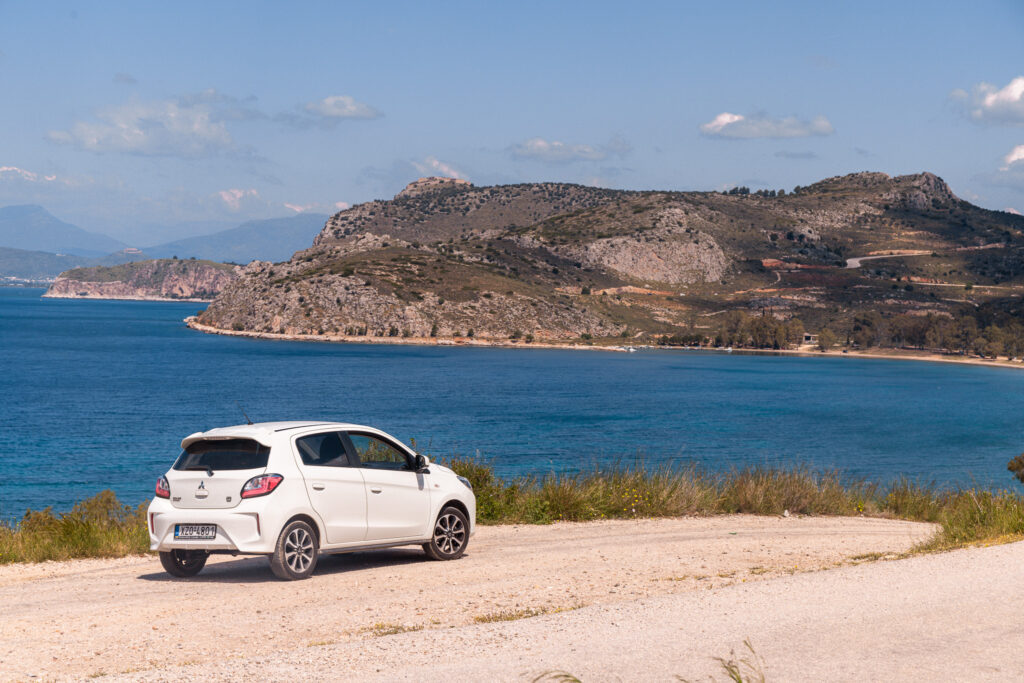
Now I’m a more mature traveler (can I barf at that?) I’m looking for travel adventures that go beyond stunning beaches and views.
So, I was thrilled at the opportunity to explore the Peloponnese region of Greece thanks to TBEX.
Briefly, TBX is one of the biggest travel blogging conferences in the world and they are usually held in lesser-known destinations. I spoke at the event, and like any good Aussie, I used that as an opportunity to explore the region more in-depth. There is no way I’m flying more than 8 hours and NOT staying longer!
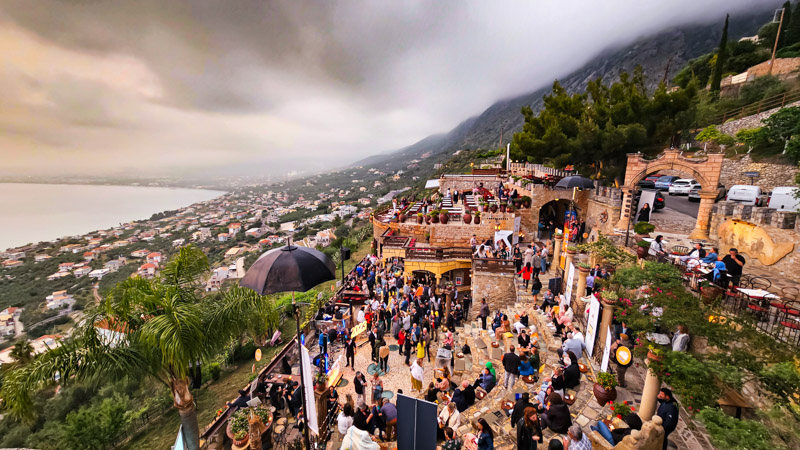
I’m so glad I did. I had a fantastic adventure that took me to the ancient wonders of Corinth and Acrocorinth to the charming coastal town of Nafplio, the picturesque vineyards of Nemea, and the vibrant city of Kalamata.
In this post, I’ll share information on the highlights of a road trip of the Peloponnese, things to do, practical tips on car rental, where to stay, and offer a 7-day itinerary outline based upon my own personal experiences (and lessons learned). If you find it helpful, please share it with a friend!
HANDY BOOKING CHECKLIST:
You’ll find more information on the following below, but to make it easy for you, here are our top recommendations for your pre-trip booking.
Why Visit the Peloponnese?
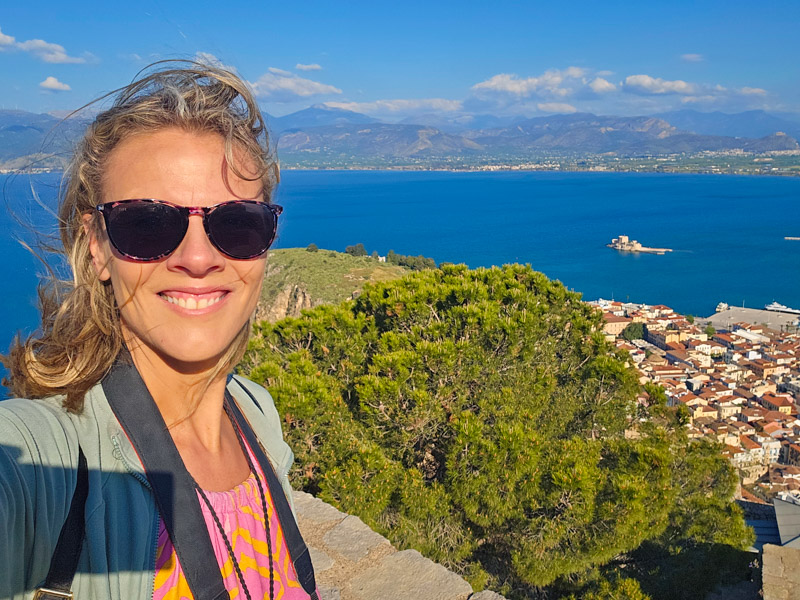
You may have heard of the Peloponnese: Think Sparta, St Paul, kalamata olives, Greek mythology, and so much more.
This region of Greece only two hours west of Athens offers a perfect blend of history, natural beauty, and authentic Greek culture. You’ll find ancient archaeological sites, breathtaking mountainous and coastal landscapes, delicious food and award winning wine.
I was surprised at the diverse travel offerings and how lush and scenically beautiful it was.
It is possible to explore the Peloponnese using public transport, or even on a guided tour, but I wanted the freedom to explore at my own pace, uncover hidden gems, and immerse myself in the local way of life.
Plus, a mom who’s traveled with her kids for 15 years, seven of those full time, I wanted an easy travel experience for this solo adventure.
So, let’s dive into the practical details of planning your Peloponnese road trip!
Firstly, Travel Insurance
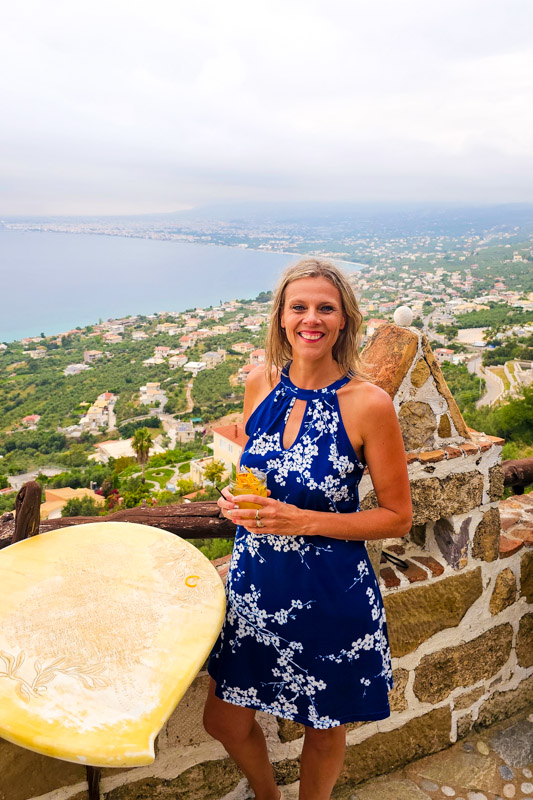
We never leave home without travel insurance (a $1,000 lesson makes sure of it!!) We even have an annual travel insurance policy with Allianz Travel – our long-term partner and sponsor of this content – so we don’t have to worry about purchasing a policy for every trip.
We hope you never have to use your travel insurance policy, but you’ll definitely want one for security and peace of mind. Should something unexpected happen that is covered by your policy, you can save you hundreds if not thousands of dollars in lost pre-paid expenses.
One of the added benefits of having travel insurance when renting a car for a road trip, is you may be able to skip the added extra expense of purchasing a Collision Damage Waiver depending on your policy, as rental car loss/damage coverage is included in some single trip and annual travel insurance policies. You may also be able to add it to your policy if it’s not!
Traveling in Europe, especially during peak season, can be a headache with delays and lost luggage. Your travel insurance policy may also help you in those instances.
This content is sponsored by Allianz Partners (AGA Service Co.) and I have received financial compensation but all opinions expressed are my own.
Hiring a Car in Greece
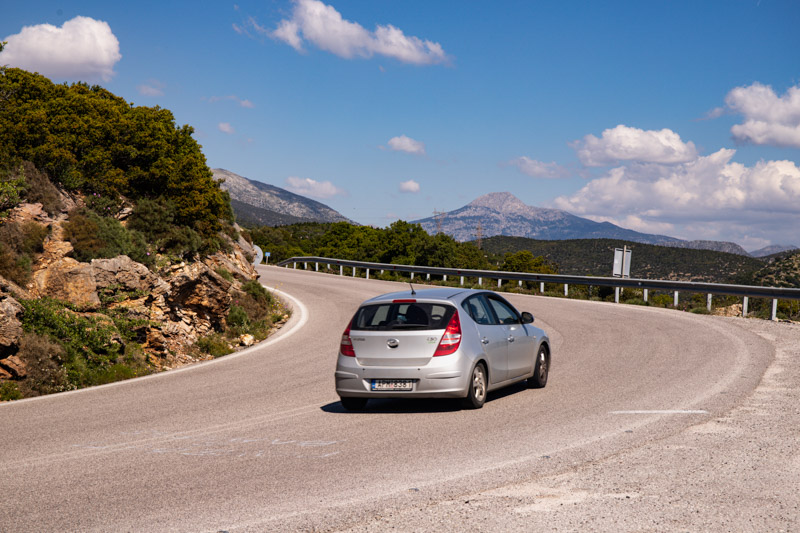
To embark on this incredible adventure, you’ll need a reliable vehicle to explore the Peloponnese. Hiring a car is a popular choice as it provides flexibility and convenience.
Opt for a small, comfortable, and fuel-efficient car to navigate the winding roads and hilly terrain of the region.
Not only that, but you may also be driving down extremely narrow streets, like I did in Nafplio and Athens. You will need a tiny car.
Be conscious of luggage. My car only had room for one suitcase in the boot/trunk.
I picked up my rental at Athens airport. As I stayed in Athens for two nights before my Peloponnese Road trip.
This meant driving through Athens and parking at my hotel (for free). I did not need it while in Athens. But it worked out more cost effective to hire the car for the entire time and drop it back off at the airport when it was time to leave.
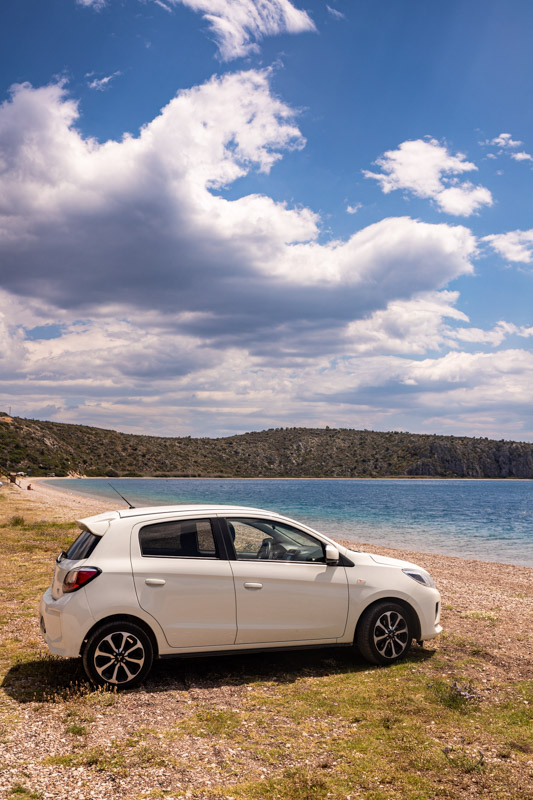
I rented my car through DiscoverCars.com. I loved the ease of their search filters to help me quickly find a reliable, efficient vehicle with great rates.
As it’s a search comparison site, you can easily find a car to suit your needs. i.e., one at the airport, or one at a rental provider in the city of Athens.
Their booking communication was excellent with helpful tips and guides on visiting Athens! They do a fantastic job of being more than just a car rental booking site.
At A Glance: 7 Days in the Peloponnese Road Trip Itinerary
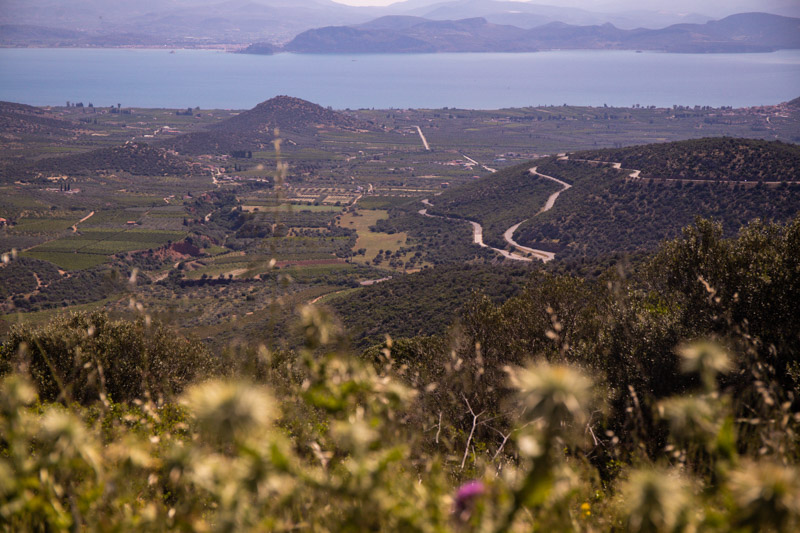
If you don’t have much time, here is a brief itinerary outline based upon my experiences. My advice is to be as flexible as you can.
I switched my days around in Nafplio as I had a full day of rain and did not want to explore the beaches and stunning viewpoints on that day!
Check out the map with all the places mentioned in this itinerary guide mapped out for you!
- Day 1: Pick up your rental car, and drive to Nafplio. Explore Ancient Corinth, Acrocorinth, and Epidaurus Theater along the way. Explore Old Town Nafplio.
- Day 2: Visit the ancient sites of Mycenae and Nemea and indulge in wine tasting. Overnight Nafplio
- Day 3: Explore the Palamidi Fortress and the beaches of Nafplio. Overnight in Nafplio.
- Day 4: Drive to Kalamata, stopping at scenic spots along the way. Explore the city center and enjoy the lively atmosphere. Overnight in Kalamata.
- Day 5: Take a day trip to Kardamyli on the Mani Peninsula. Spend the day relaxing on the beautiful beaches of Kalamata or take a day trip to nearby attractions such as the Mani Peninsula or the stunning Voidokilia Beach. Overnight in Kalamata.
- Day 6: Hike the stunning Polylimnio Waterfalls and the Voidokilia Beach
- Day 7: Depart for Athens, returning to your rental car at the airport before your departure.
Map of this Peloponnese Itinerary
Below you will find a map of this itinerary, including all the key attractions, places to eat, and places to stay.
Alternative Options
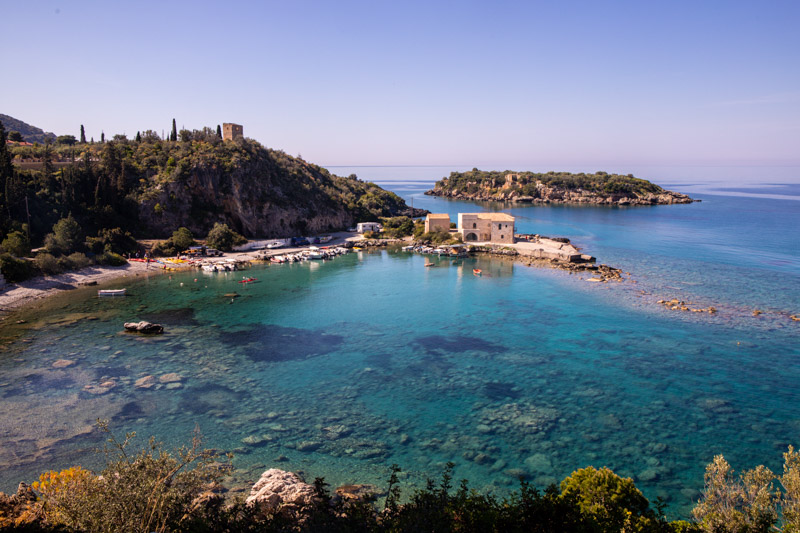
If you have more time, or want to add in a few other top attractions in the Peloponnese to your itinerary, here are some suggestions (I’m coming back for them)
- The Site of Ancient Olympia (home to the first Olympic Games)
- The ancient site of Mystras
- Sparta
- Mani Peninsula
- Costa Navarino (Navarino Bay)
- You’re also not too far from a ferry ride over to the island of Zakynthos.
- Take a boat trip over from Piraeus to Hydra
- Delphi Archeological Site
And I highly recommend you explore Athens either before or after your Peoloponnese road trip. I’ll have a post sharing my tips for Athens soon. If you join our email list, you won’t miss it!
The Best Peloponnese Road Trip Itinerary
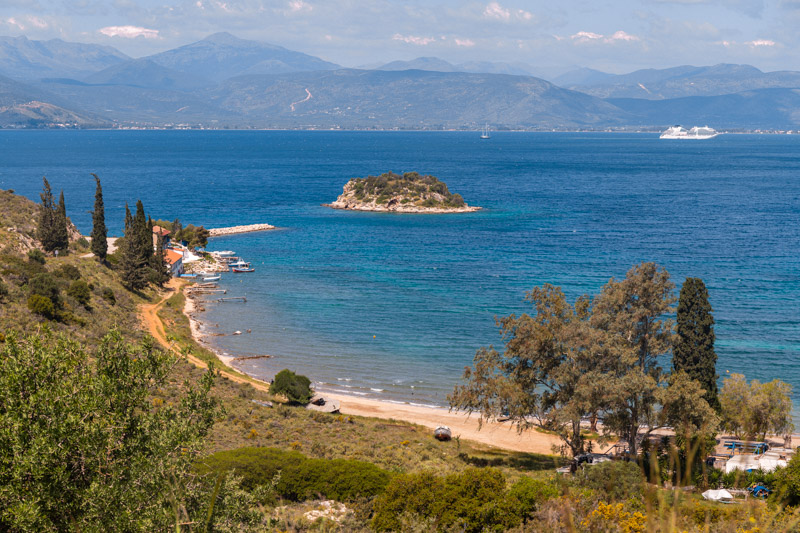
Below is how I recommend you spend a seven day itinerary. I’ve broken the following attractions and things to do in the Peloponnese into the order in which I did them, but you can switch up this itinerary into any order that suits you.
Day 1: Ancient Corinth & Acrocorinth
I skipped the town of Corinth due to time and low expectations. Instead, I chose to visit the following outstanding ancient sites. I was quite blown away by them.
Stop 1: Corinth Canal
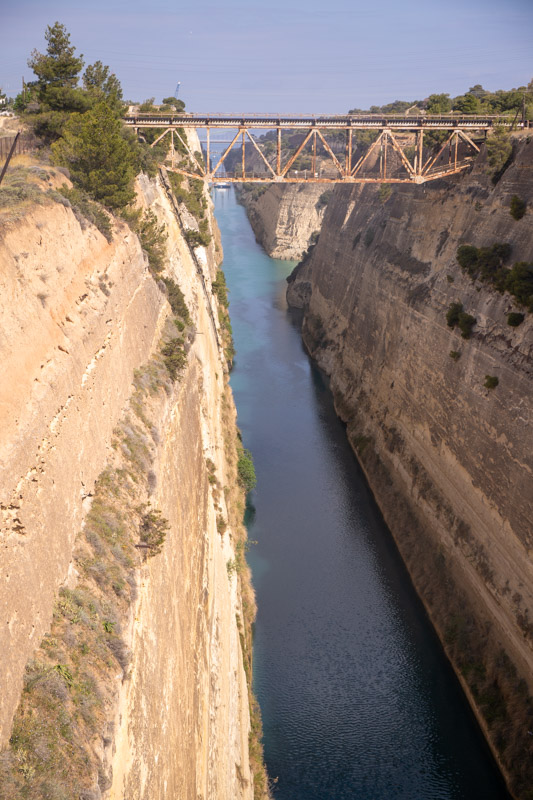
Firstly, you may want to stop off at the Corinth Canal. I found it overrated but I know many others who love it.
The Corinth Canal is an engineering marvel that connects the Aegean Sea with the Ionian Sea. It is incredibly narrow and is meant to be a sight if a boat is coming down it.
This can be an easy five-minute stop on your road trip, and you’ll have to pass through it anyway so you might as well. There is a parking lot on the right just as you cross the bridge (you’ll see loads of buses). Then walk on the bridge and take a peek.
Stop 2: Ancient Corinth

Have you heard of St Paul and his letters to the Corinthians?
This is where history will come alive for you as it’s where St Paul lived for 18 months in his attempts to convert the gentiles. It’s a top attraction in the Peloponnese for Christians.
You’ll only need about an hour to explore the archaeological site of Ancient Corinth.
Wander among the well-preserved ruins and temples, marvel at the iconic Temple of Apollo, and the Bema, a large, elevated rostrum standing prominently in the centre of the Roman Forum where St Paul was put on trial for illegal religious teachings but was found not guilty because he was just having discussions.
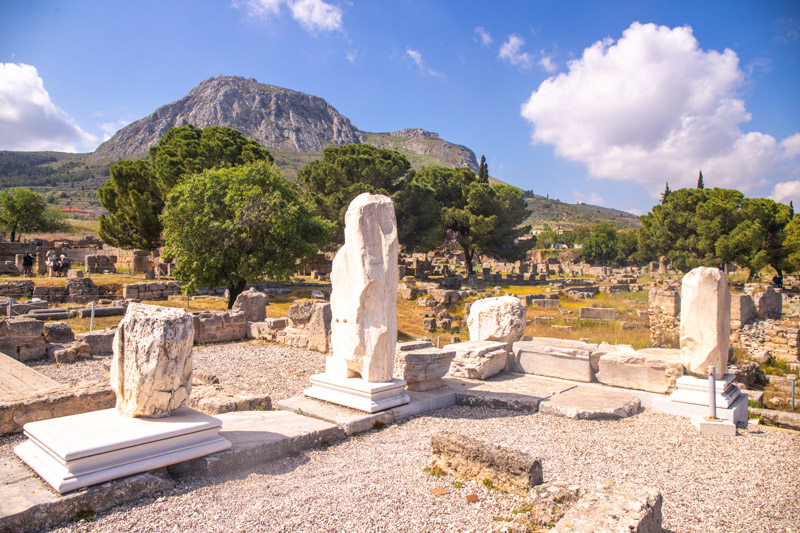
There’s also a small archaeological museum, which highlights artifacts from the area.
Outside of the Ancient Corinth Gates are a row of restaurants to fuel up with coffee and lunch before driving up the mountain.
I had no idea you could get a self-guided audio tour of Ancient Corinth. I wish I knew as I really enjoyed the one I had touring the archeological sites in Athens.
Stop 3: Acrocorinth
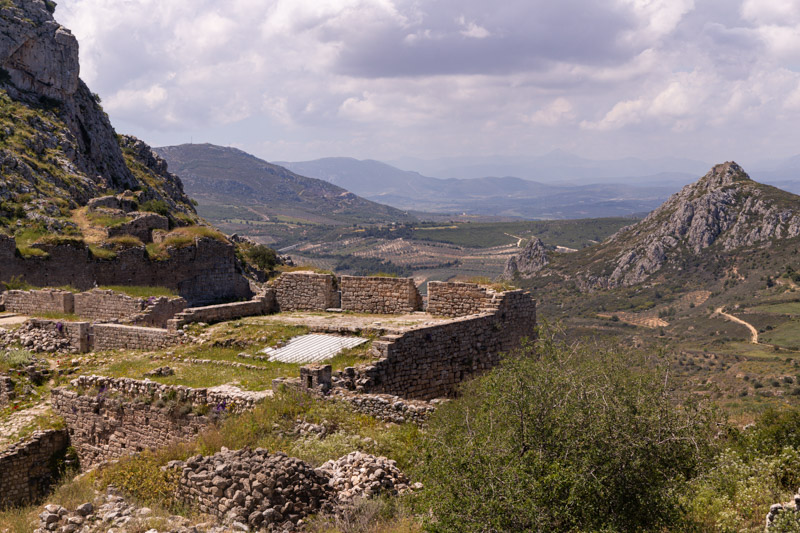
All good things come to those who are prepared to climb. Acrocorinth is where you can escape the crowds. Acrocorinth was a maybe for me on my road trip and quickly became one of my favorite attractions in the Peloponnese.
I saw it sitting high atop the mountain from Ancient Corinth and was intrigued to follow that winding mountainous road.
Acorointh is the ancient fortress perched so high in order to monitor the isthmus of Corinth and protect Ancient Corinth below.
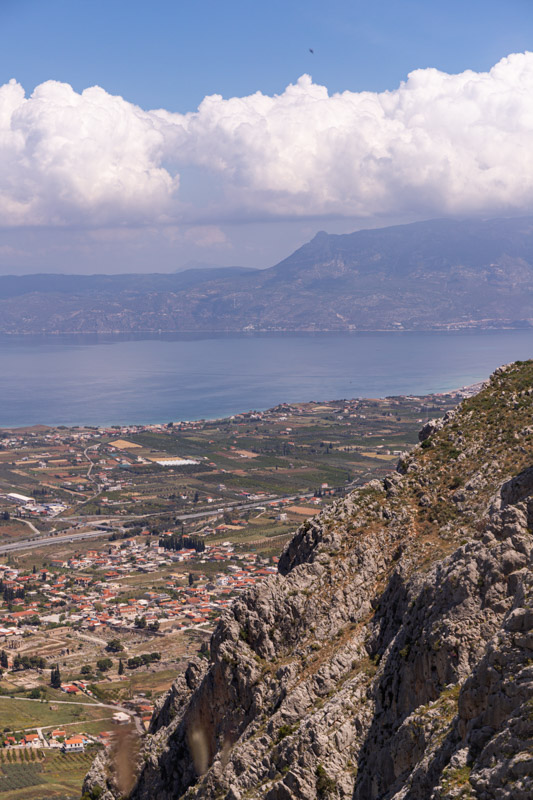
There are multiple trails running through the crumbling ruins, all leading to the most spectacular views.
The rich history and stunning vistas make Acrocorinth a must-visit attraction in the Peloponnese.
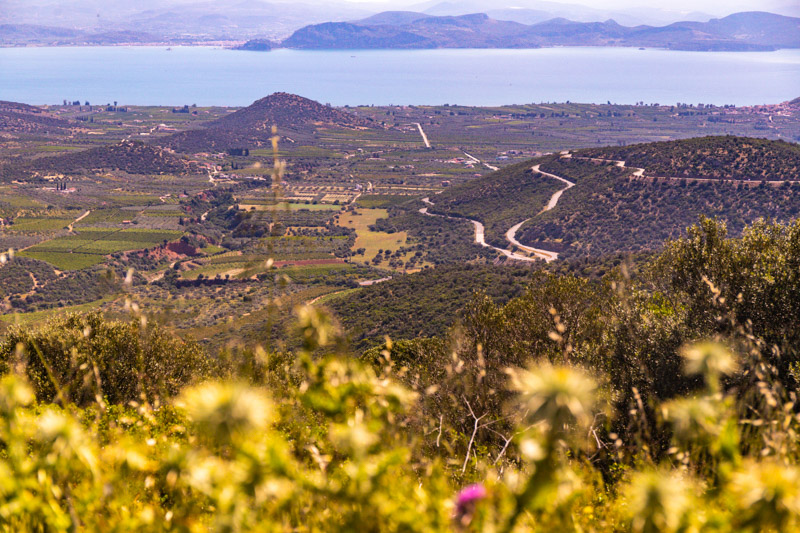
Stop 4: Epidaurus
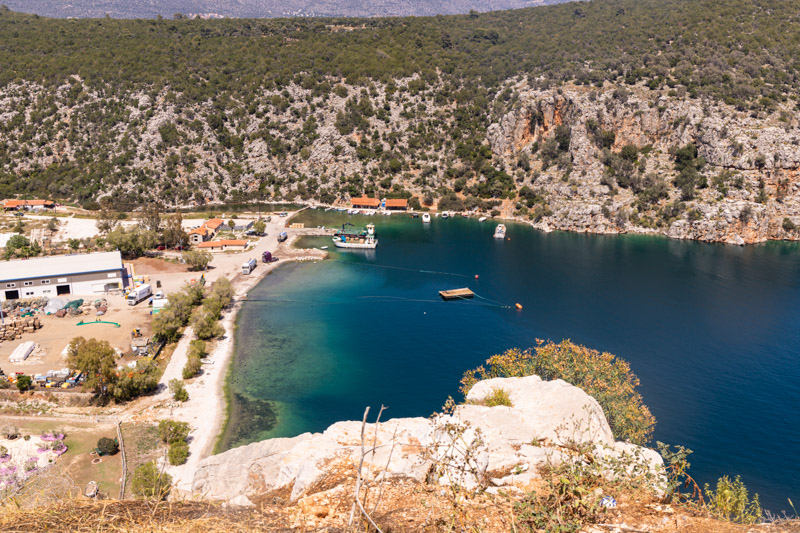
From Acrocorinth, drive to Epidaurus and enjoy some stunning coastal views along the way.
Epidaurus was a small city in ancient Greece, on the Argolid Peninsula at the Saronic Gulf.
Stop 5: Epidaurus Theater

Visiting the ancient Theater of Epidaurus is an absolute must for any history enthusiast or theater lover.
This magnificent UNESCO World Heritage Site, and home of ancient healing grounds, holds immense cultural significance.
The Theater of Epidaurus, dates back to the 4th century BC, and was built to host religious ceremonial events in honor of God Asclepius.
Walk to the top for beautiful views of the lush valley surrounding it. It is renowned for its near-perfect acoustics, allowing the audience to hear even the softest of whispers. Stand in the middle of the stage and whisper to a friend up at the top level and test it out!
It’s a unique opportunity to witness the enduring legacy of Greek theater and experience the magic of this historic venue. In summer, it hosts performances of ancient Greek drama.
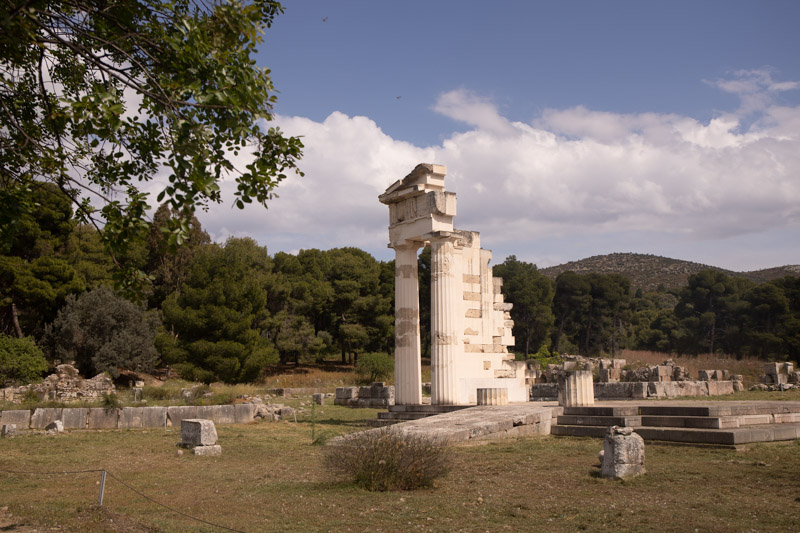
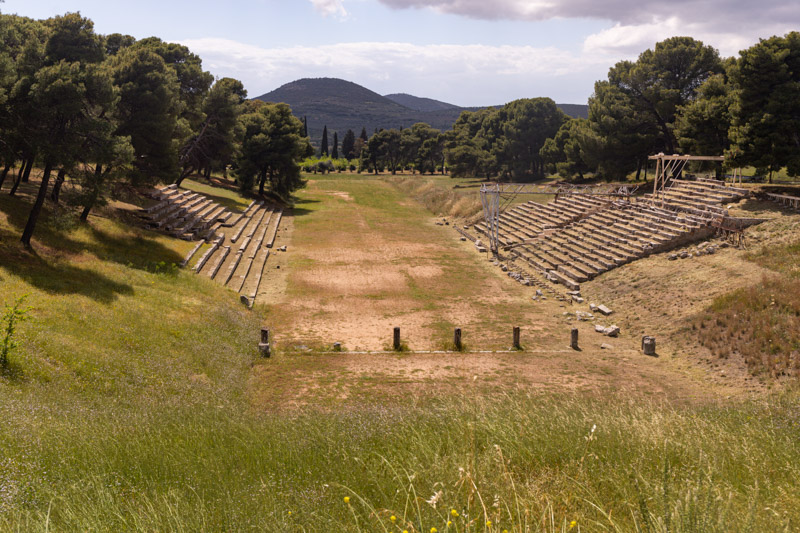
Just steps away from the theater is the ancient Asklepios sanctuary, dedicated to the God of Healing. It included a temple with the god’s cult statue; an altar; a sacred spring; an offering pit; two stoas; and an athletic field.
DO NOT buy a coffee from the cafe here – it was uber expensive and not very good. The freshly squeezed orange juice, however, was the refreshing burst of hydration I needed.
Epidaurus is about 30 minutes from Nafplio (your overnight destination).
Day 2: Day trip to Mycenae and Nemea for Wine Tasting
On my one full rainy day in Nafplio, I decided to head to the ancient site of Mycenae and do some wine tasting in Nemea. Both are an easy day trip from Nafplio (only forty’ minutes’ drive in total)
Stop 1: Ancient Mycenae
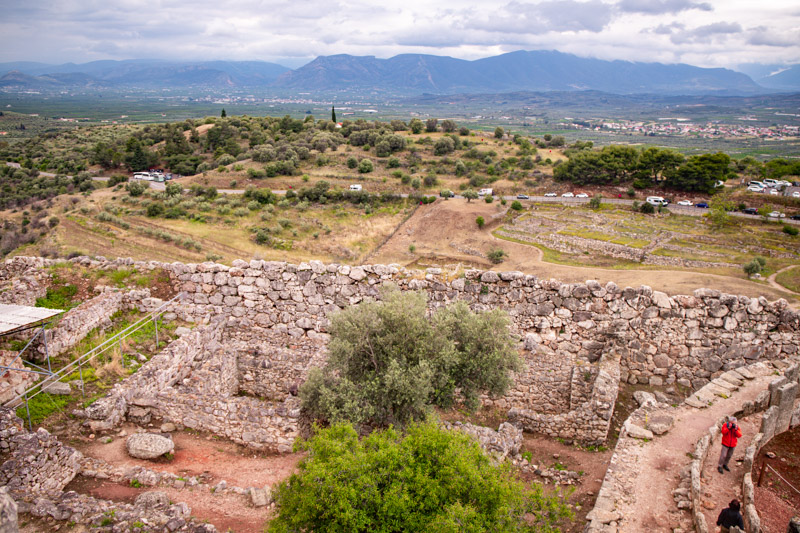
First stop only twenty minutes’ drive away was Mycenae, an ancient archaeological site that holds immense historical and cultural significance.
I knew about this only because Savannah learned about the powerful Mycenaean civilization in school, which flourished during the Late Bronze Age.
People visit to explore the remnants of Mycenaean civilization but also to delve into the rich tapestry of Greek mythology.
This was the town of the legendary King Agamemnon, the leader of the Greeks during the Trojan War. It’s also founded by Perseus, son of Zeus and Danae, and heroes immortalized by the Homer’s Epics.
Surrounding the ruins are the remains of huge Cyclopean walls said to be constructed by the mythical cyclops.
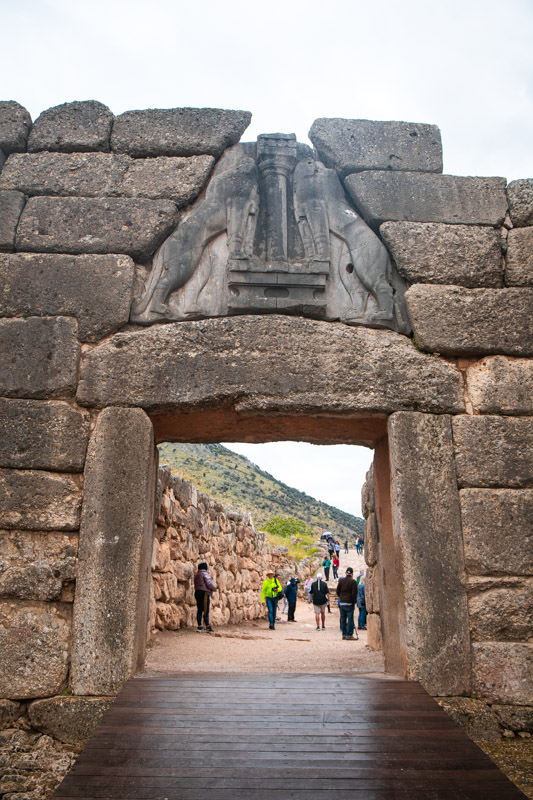
Begin by walking through the famous spot in Mycenae, the Lions Gate into the old civilization to wander amongst the ruins of palaces, tombs, and fortifications that once symbolized the might and opulence of Mycenae.
There are different burial chambers called tholos, or beehive tombs, which are a circular vaulted chamber with an entrance way.
A highlight of Mycenae for visitors is the Treasury of Atreus, the vaulted tomb of King Agamemnon.
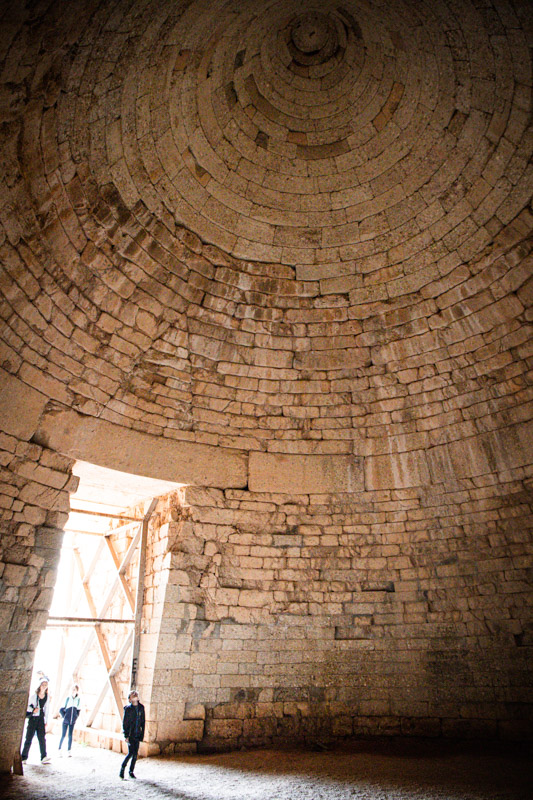
There were too many school tour groups for me to really enjoy the tomb. But I did enjoy the ruins of Mycenae and the impressive views of the surrounding countryside.
The Lion’s Gate is another notable landmark in the site.
Mycenae is a pilgrimage for history enthusiasts, offering a fascinating glimpse into Greece’s ancient world and leaving visitors in awe of the incredible achievements of the Mycenaean civilization.
BOOK IN ADVANCE: This skip the line ticket is actually cheaper than what I paid at the gate. It also includes an audio guide.
Stop 2: Wine Tasting in Nemea

Nemea is known for its vineyards and the legendary Ancient Nemean Games held every other year in honor of Zeus.
I did not get time to visit Ancient Nemea (And I was a bit ancient Greek tired!), but you can visit to see the Temple of Zeus and the ancient stadium.
Instead, my purpose for Nemea was wine tasting! I really wanted to join a tour for this so I could enjoy the tasting without worrying about blood alcohol limits. But it didn’t happen, so I chose to visit two vineyards, spacing them out with tasting to equal one glass at each over a prolonged period.
Nemea is one of the best wine regions in Greece, known for the acclaimed Agiorgitiko grape variety.
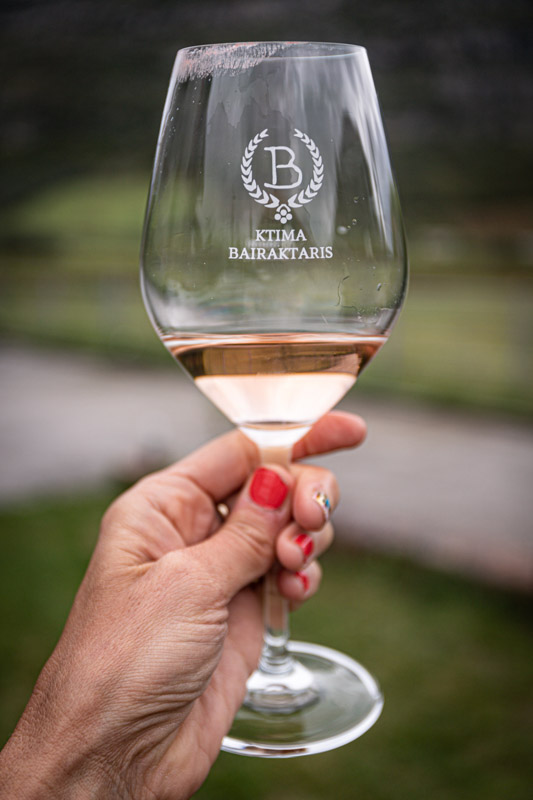
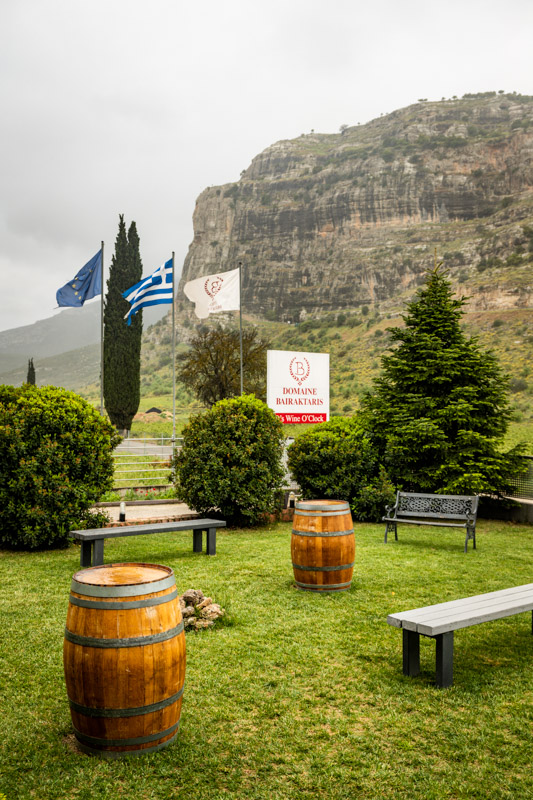
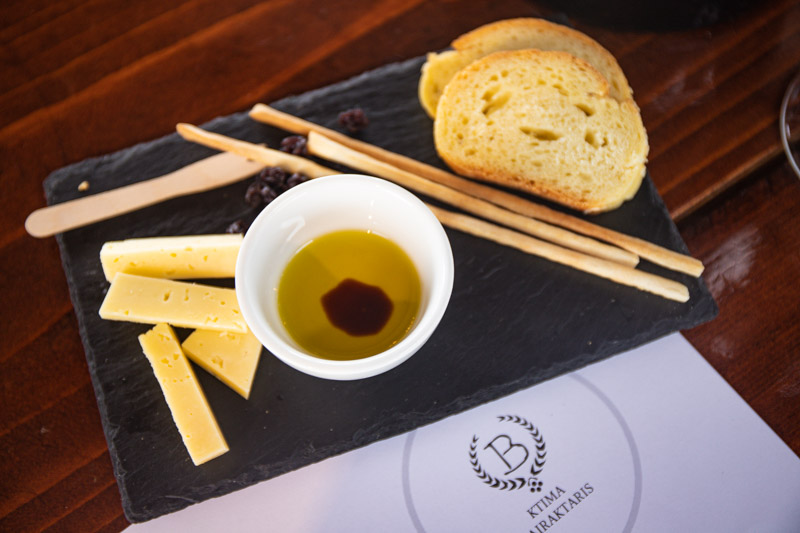
I arrived at Ktimi Bairaktaris Winery. at the right time. A tasting tour had just started so I joined for just 15 Euro.
We went behind the scenes to learn about the process of making wine before sitting down in the tasting room. They bought out a small charcuterie board of cheese, bread, and olive oil and three samples of wine: white, rose, and red. All were delicious!
I quickly became a fan of Greek wine on this Peloponnese trip.
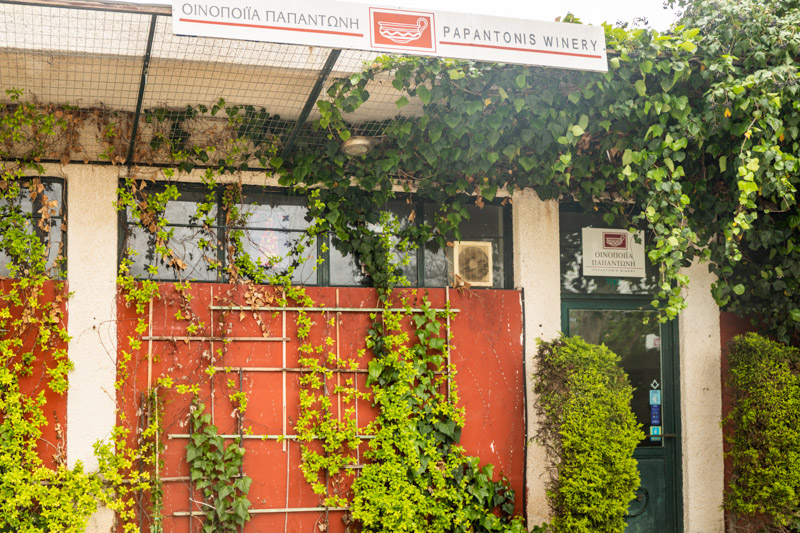
My next winery was Papantonis Winery south of Argos, only twenty minutes from Nafplio. I don’t know how I found this place, but I’m so glad I did.
This was no fancy winery with a small tasting bar amongst the barrels and office space. Owner Antonis joined me with a glass of wine and brought out a plate of the most delicious feta cheese and olives (grown on his farm) and poured me a glass of wine way beyond normal sampling size.
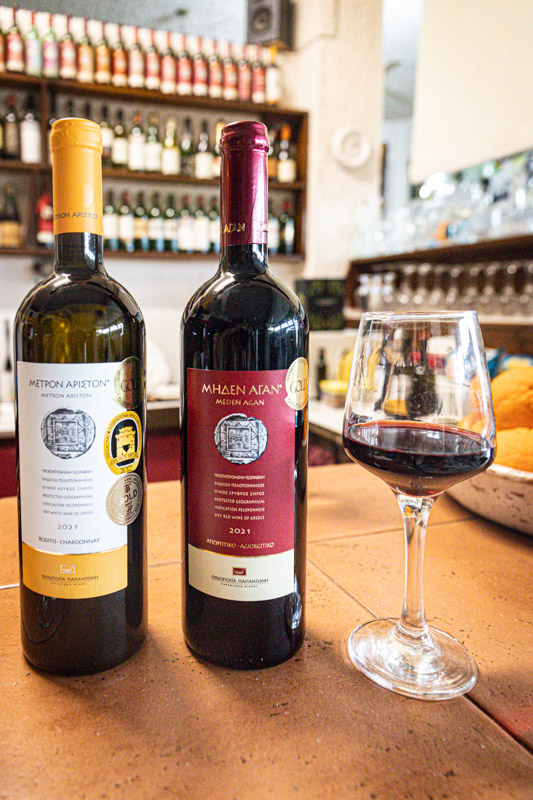

This was the one time I was rueful I was traveling on my own and driving! I had to politely decline the huge servings, taking small sips of delicious chardonnay and possibly one of the best red wines I’ve ever tasted – Meden Agan made from the Agiorgitiko grapes.
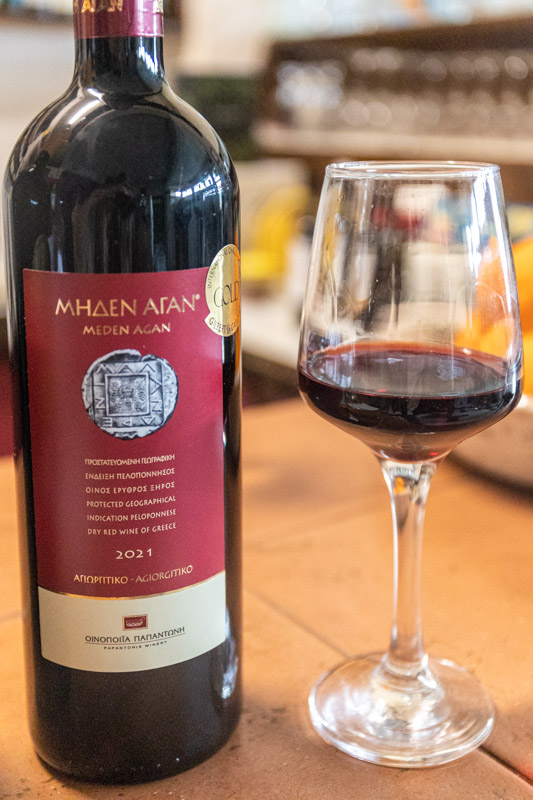
Antonis told me of his life working as an accountant in Libya, Nigeria, and Saudi Arabia, saving up enough money to quit and start this award-winning winery and farm. The wine was so delicious and the conversation so fun, I knew I had to cut the visit short!
But, not without taking a bottle of that red wine home with me to savor properly in the US.
WINE TOUR: This wine tasting tour also includes a visit to Ancient Nemea. It is expensive, and you can only book with two people. I thought it meant 2 people minimum on tour, but it won’t let you book unless you have two people. I tried multiple booking sites. Hopefully you have better luck if you don’t want to drive. I made it work but be vigilant.
Day 3: Nafplio / Nafplion
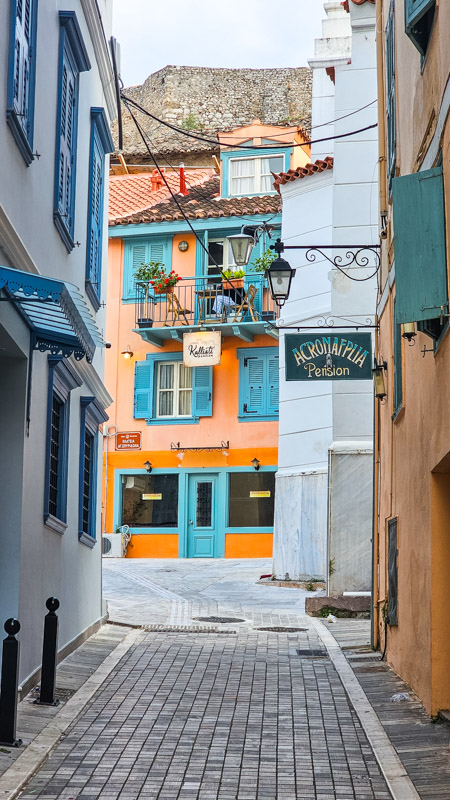
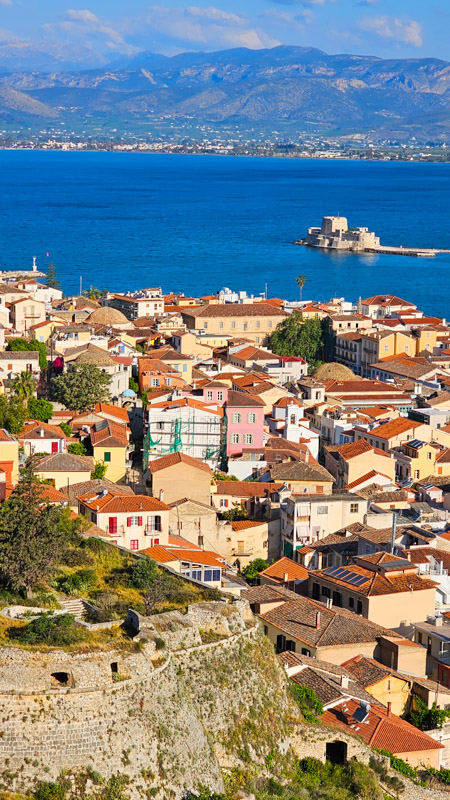
Now it’s time to explore one of my favorite places in the Peloponnese, Nafplio, the first capital of Greece.
It’s known for its romantic ambiance and Venetian charm, which you’ll fall in love with on your first steps through the meandering cobblestone narrow streets of Old Town.
Wander and wonder at the colorful buildings and shops, linger in inviting cafes, and enjoy sunsets on the water’s edge.
Here are a few other top things to do in Nafplio.
Stop 1: Hike the 999 steps to the Palamidi Fortress
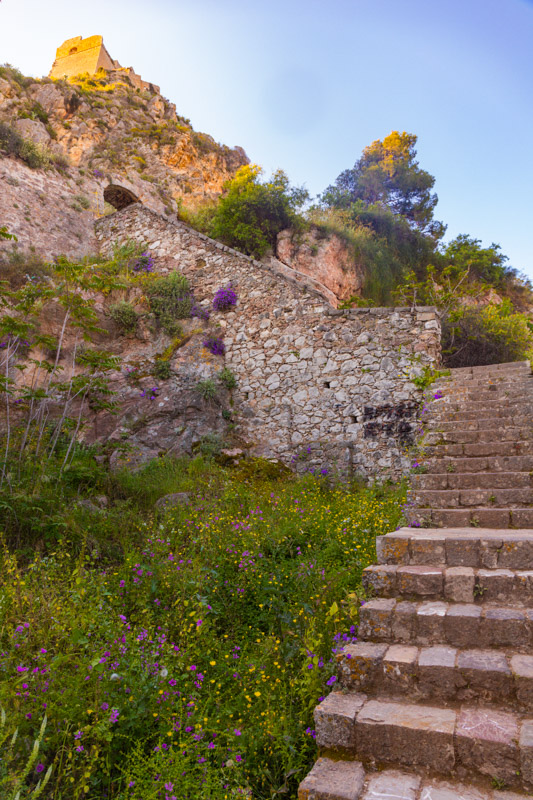
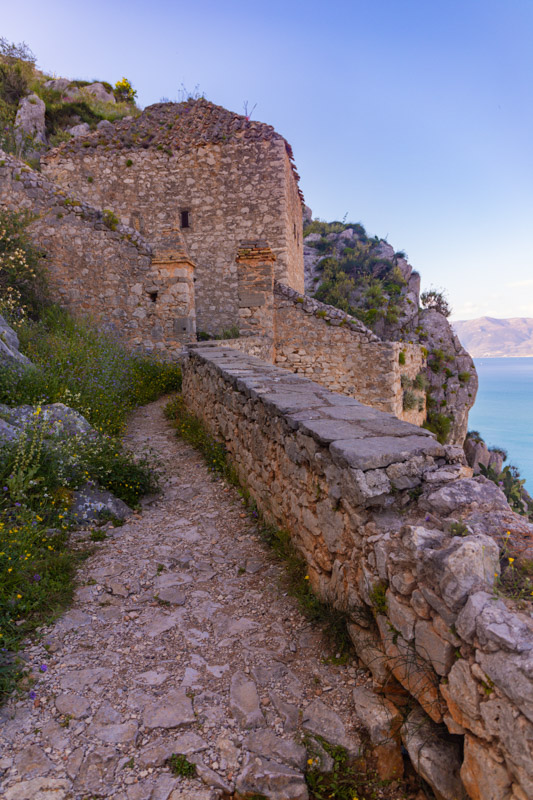
Hiking to Palamidi Fortress, a citadel perched on top of the hill behind Old Town, is not as exhausting as it sounds. The reward will be breathtaking views over the town and the Argolic Gulf.
Built by the Venetians in the 18th century, this fortress served as a stronghold to protect against enemy invasions and played a significant role during the Greek War of Independence.
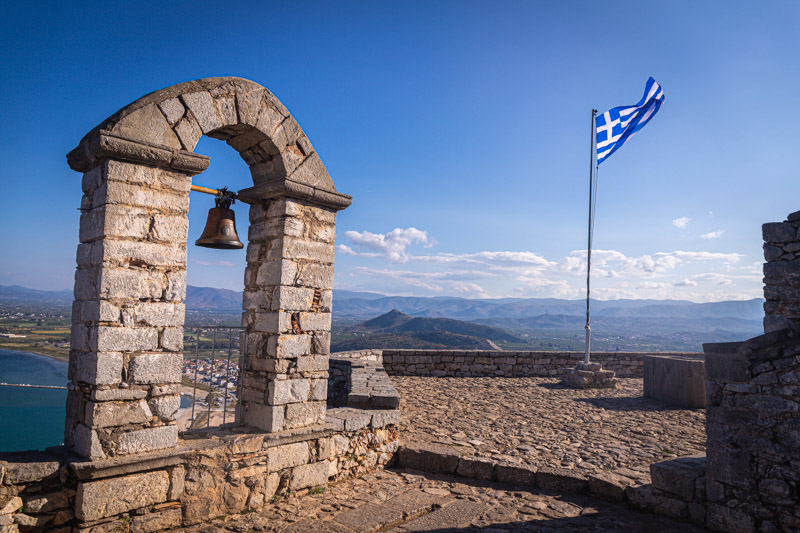
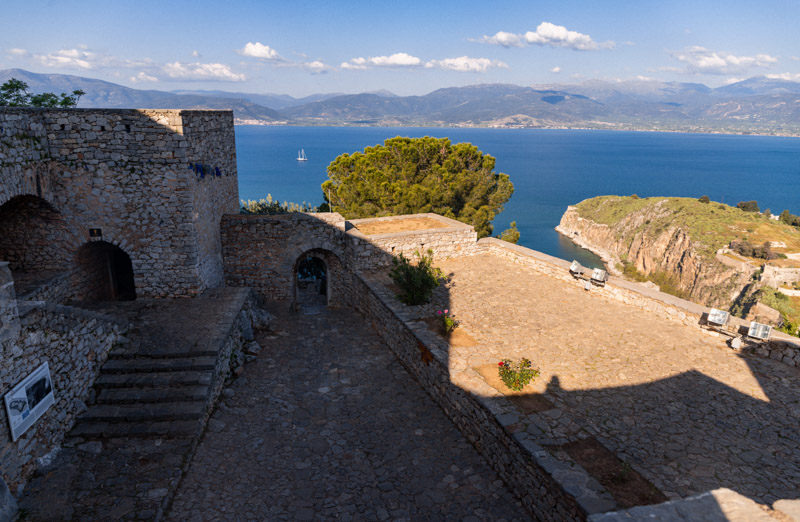
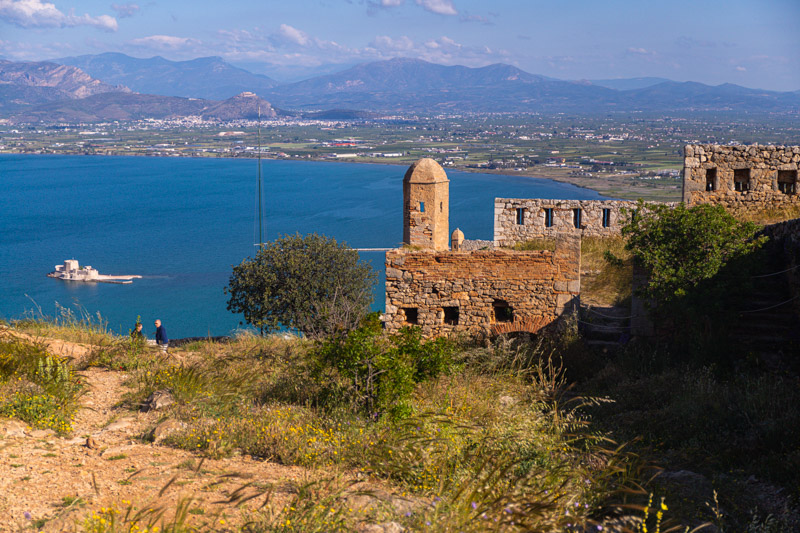
You can wander through the fortress and enjoy the views. Be sure to crawl your way into the damp, dark prison cell as a reminder to follow the law!
Go early for the best light conditions and to avoid crowds.
Stop 2: Kayak to Bourtzi Castle
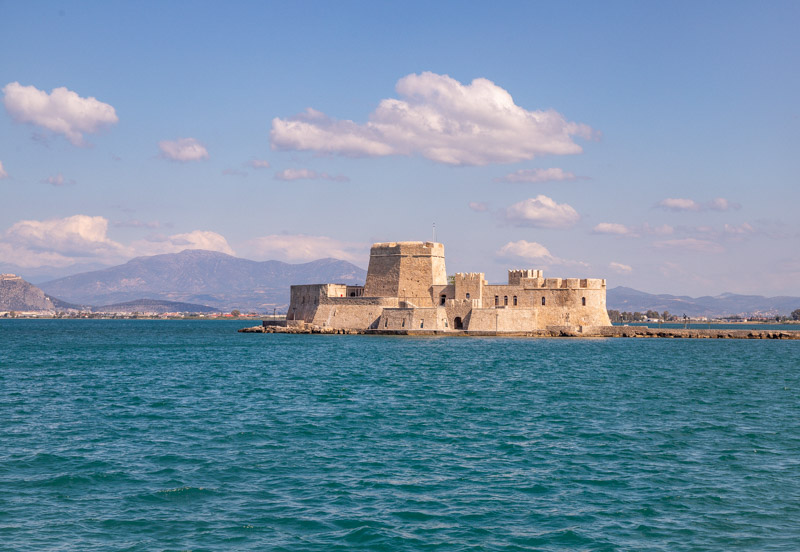
This castle, along with Palamadi, is considered one of the landmarks of Nafplio. You will see it around every corner and on top of every vantage point. Its original purpose was to protect the city from pirates and invaders from the sea. Through the years,it’s also been a prison, residence, tourism offices and a luxury hotel and restaurant.
You can visit by boat, or on a kayaking trip. Apparently, you can rent kayaks, but I could not find any information. It may have been to early in the season. Here is a sea kayak tour, although it’s a little pricey.
Sadly, I did not get time to kayak over to the iconic Bourtzi, a small, fortified island located just off the coast. It was high on my list of things to do in Nafplio.
Stop 3: Explore the Nafplio Beaches
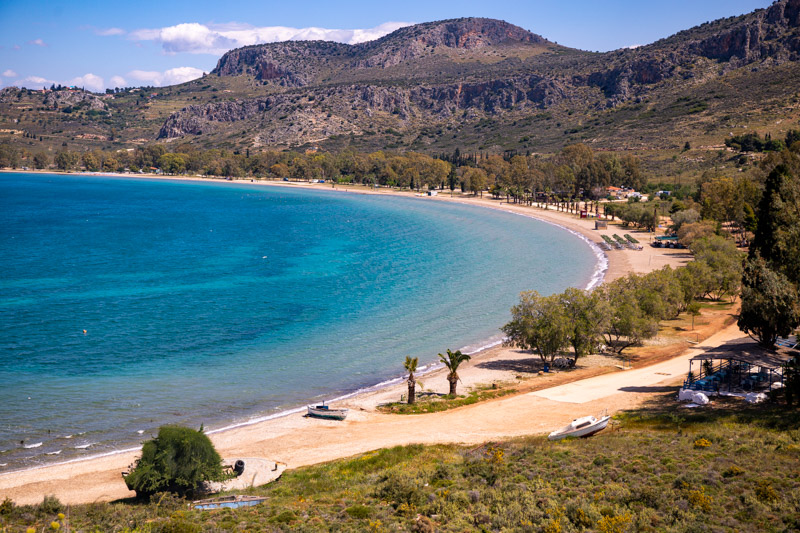
One of my favorite days on my Peloponnese vacation was driving to the nearby beaches of Nafplio. My windows were rolled down, Pearl Jam was blasting, and weather conditions were near perfect.
Choose how far you want to go. I drove all the way to Kondyli Beach (Paralia Kondyli). This is a more remote beach situated on Vivari Lagoon with no facilities and little people. You can even camp on a strip of beach here.
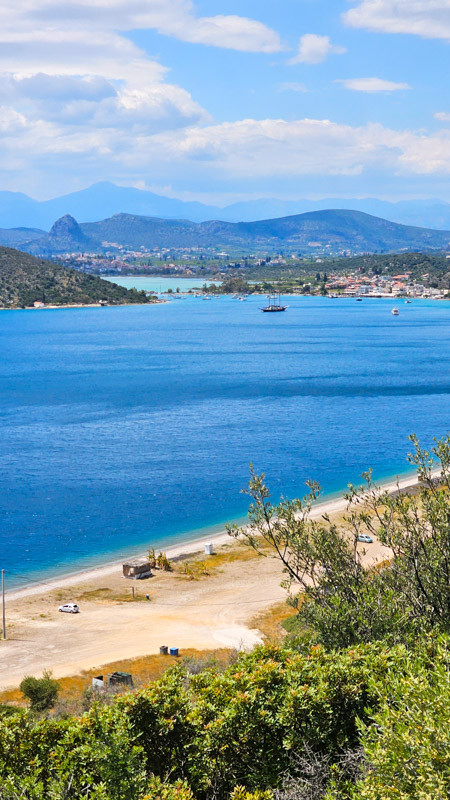
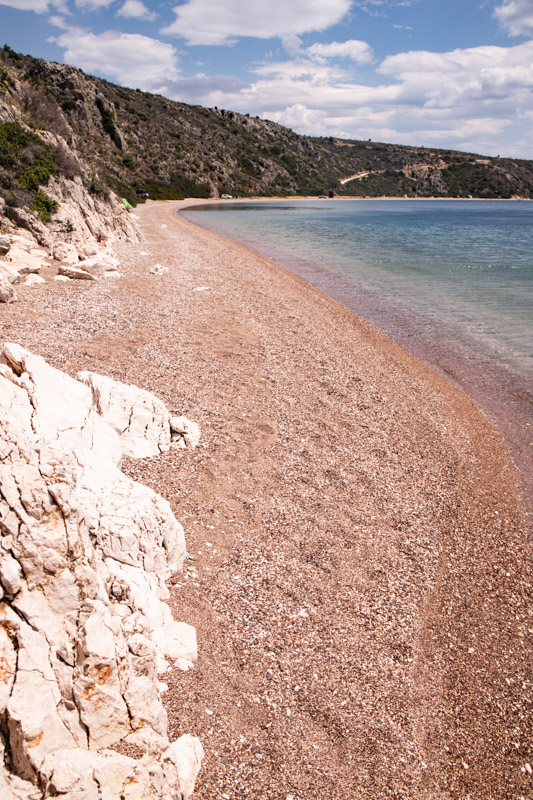
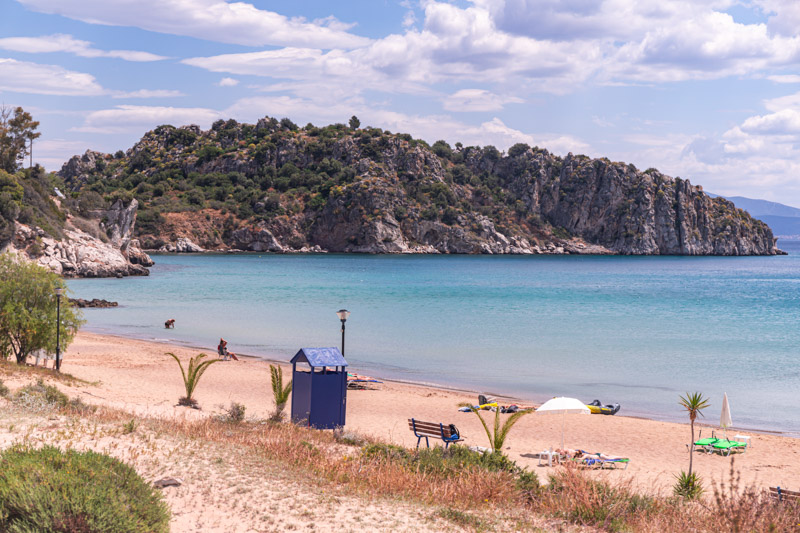
Along the way I stopped at Karathoas Beach (Paralia Karathonas) – it was really windy here, so I didn’t stay long – and Tolo Beach (Paralia Tolo), where you’ll find a small town with lots of restaurants and amenities.
Stop 4: Walk from Old Town Nafplio to Arvanitias Beach
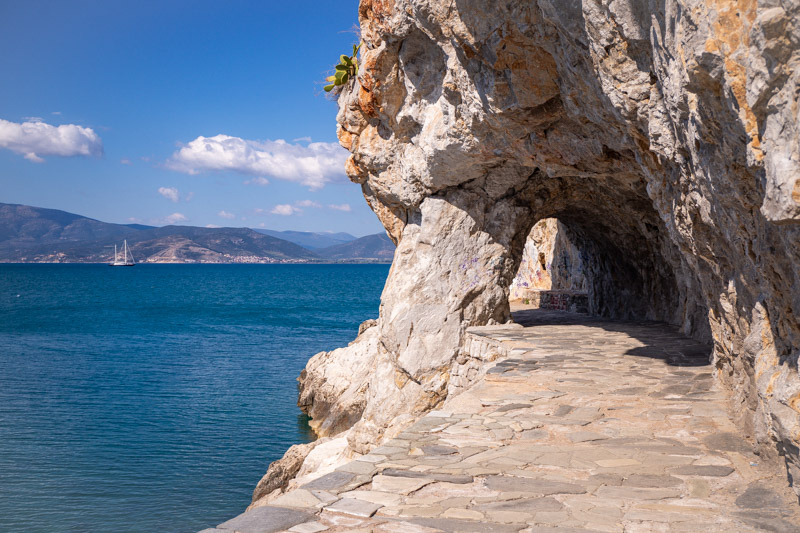
No need to miss out on Nafplio Beaches if you don’t have a car – do this as well even if you do!
You can either walk to Arvanitias Beach from Palamidi Fortress or walk along the coastline from Old Town.
The 1km Arvanitia Promenade is one of the most popular walks in Nafplion. You’ll have spectacular views the whole way and get to finish at the stunning Arvanitias Beach for a swim.
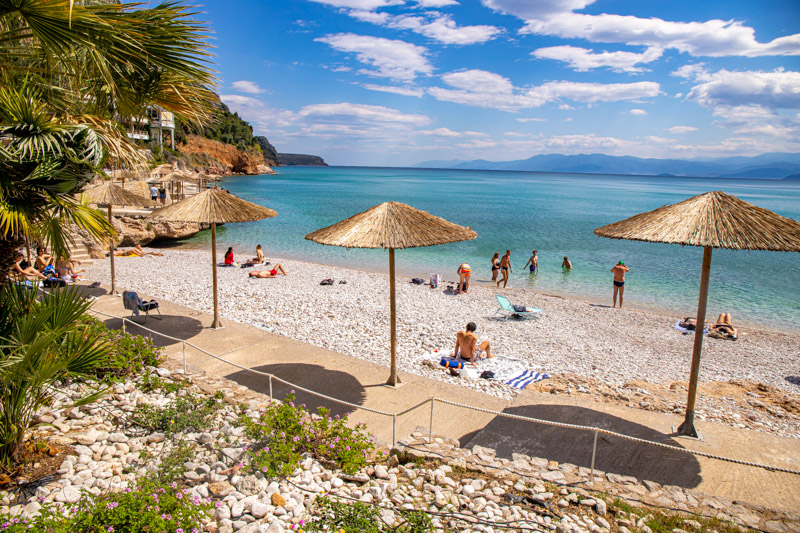
It’s a pebble beach so wear shoes down to the edge and the beach is small so come early to avoid crowds. My icy swim here in the May waters was very refreshing after a near perfect day hiking and beach road tripping.
Where to Eat in Nafplio
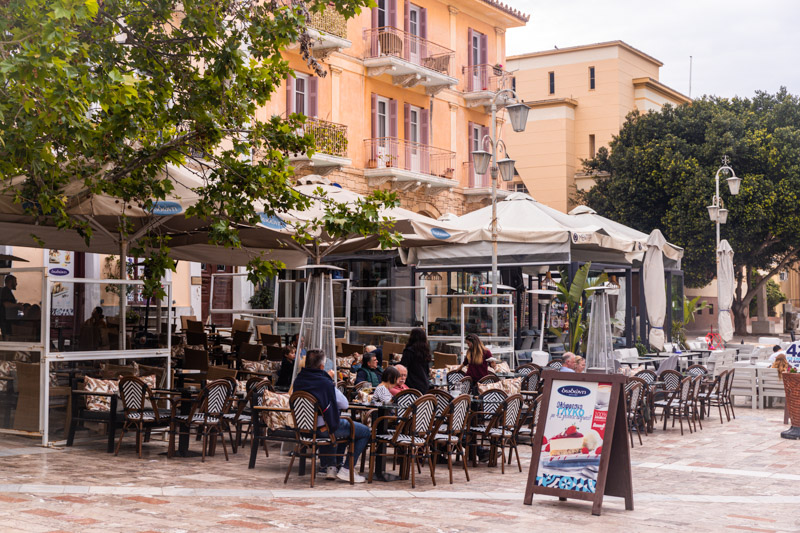
You have endless choices of tavernas, restaurants and cafes in new and Old Town. I preferred those tucked away on the streets of Old Town, rather than the overpriced ones on the waterfront. I was surprised that a couple of them (in the sunset viewing area) had a dominant American menu.
Oh no. I came to Greece to eat delicious Greek food. Especially given Nafplio is on the sea and you have endless options for delicious seafood fresh from the Mediterranean.
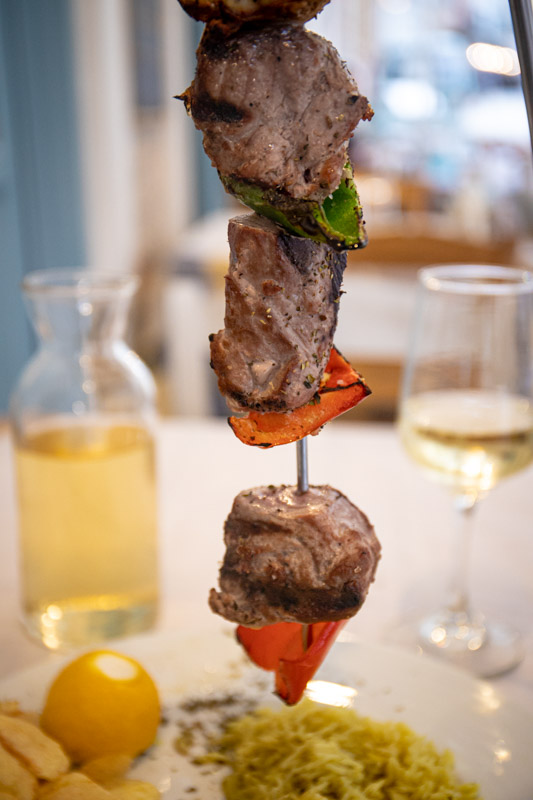
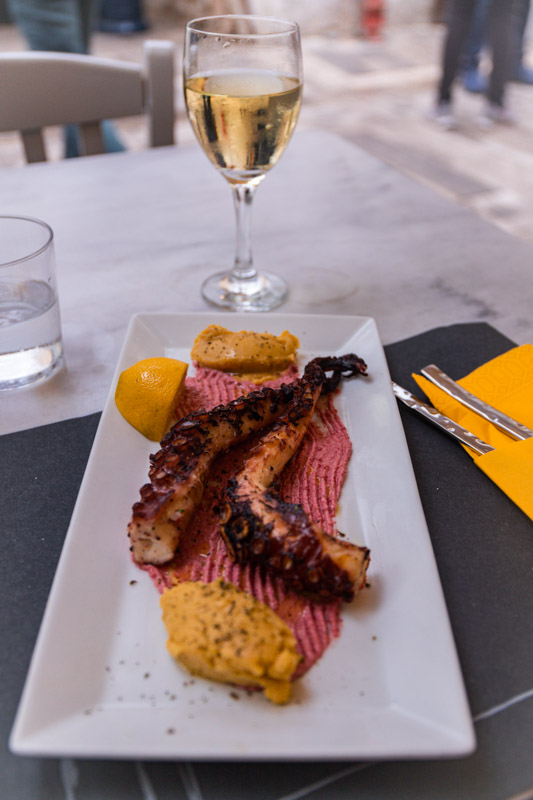
My absolute favorite restaurants in Nafplio were:
- Alaloum: Many of you saw my delicious tuna souvlaki (fresh from the nearby Nafplio waters) and 5 Euro half liter of wine on my reels. I loved the prices, delicious food, and friendly service of this Nafplio Greek restaurant.
- Again, offering great service and a delicious dish of octopus was ΣΟΥΡΕΑ, which means Surreal in English. Yep. That’s Nafplio.
- A wine at Mentor Bar on Syntagma Square was fantastic for people watching, especially after my extraordinary day at Palamidi Fortress and the beaches of Nafplio.
- I didn’t find a coffee to rave about, but my Greek coffee paired with Greek yogurt for breakfast at Kalimera was good.
Locations of the above are in the map of this itinerary.
Where to stay in Nafplio
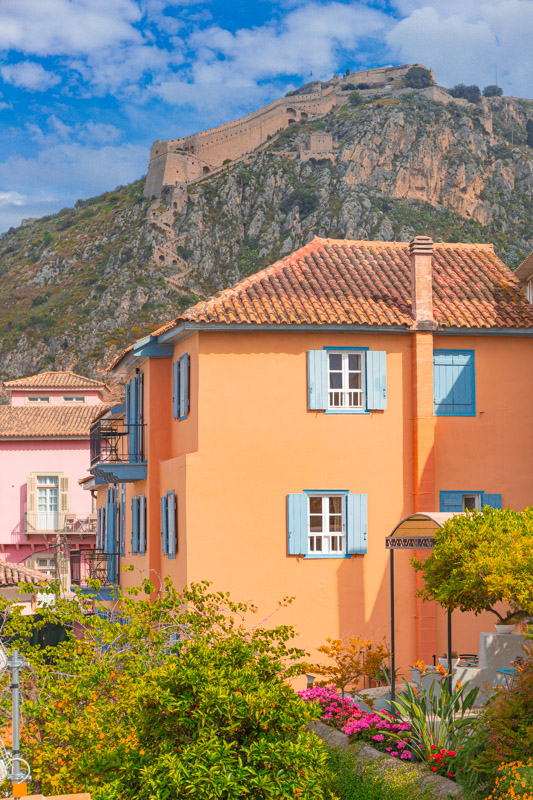
I loved my little pension at the Kapodistrias Hotel in the Old Town. I stayed in the Nafplios room, which was tiny, but adequate since I was rarely there.
Thanks to the gorgeous views from my small balcony, easy access to walk to Nafplio attractions, and the price of sixty-five euro a night, I was very happy.
Day 4: Kalamata, Home of the Olives
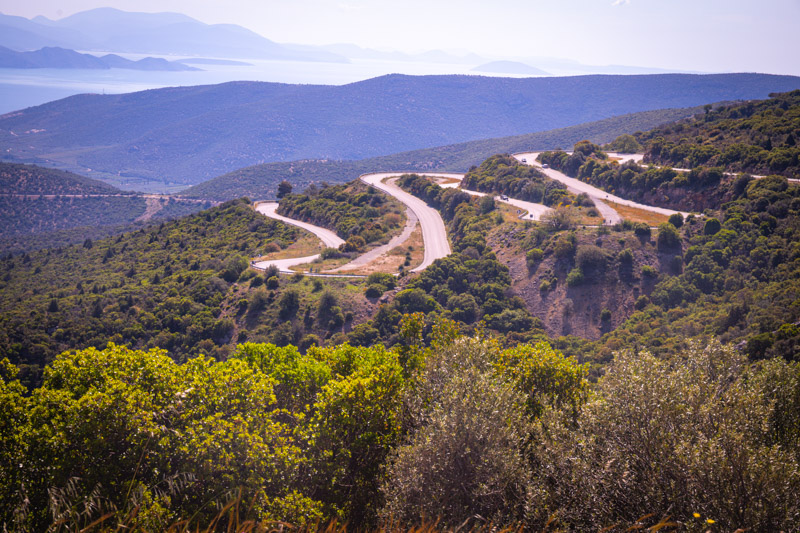
Give yourself time on your drive to Kalamata from Nafplio to enjoy the views as you wind up and down the mountainous pass. Watch for motorcycles – it’s my favorite scenic drive of theirs.
It’s only an hour and a half to the vibrant city of Kalamata, famous for its olives and picturesque beaches. Before this trip, I never knew kalamata olives were named after a region!
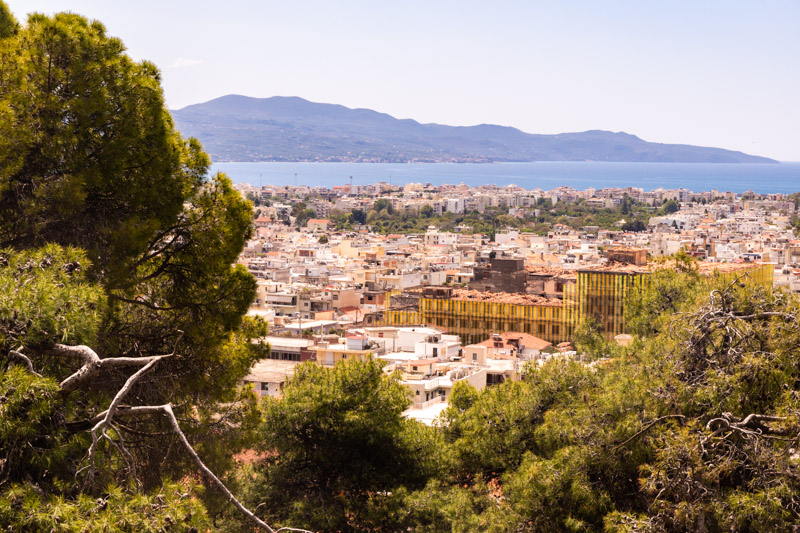
I stopped at Kalamata’s Castle on the way in. There is not much to see here, except beautiful panoramic views out over the city.
Along Kalamata Beach is a palm-fringed waterfront promenade great for stretching your legs or to walk 20 minutes into town. I did not get to explore much of Kalamata City as I was busy with the conference or exploring attractions nearby.
You have the car so take advantage of enjoying ancient historical sites, stunning beaches, and adventurous hikes of the Kalamata region.
Where to Eat in Kalamata

There are a plethora of restaurants and beach bars along the way. We ate a lot of delicious food served at the conference and party venues so we did not eat out a lot.
But here are a few I enjoyed.
- I had a delicious brunch and flat white at Blossom Owl Coffeeshop in Downtown Kalamata. They are most known for their huge variety of delicious pancakes (unfortunately, I’m gluten free!)
- I loved the vibe of Ego Bar, where we had lunch every day during our conference. It’s actually normally just a bar.
- Da Luz had a cozy ambiance, great food and wine, and excellent service. Don’t miss the seafood saganaki.
- The flat white at Aurora Cafe on the promenade closer to Kalamata town was unbelievably good – and only 2.50 euros. (It’s actually inside a fashion store, but has a side window and seating area.)
Where to Stay in Kalamata: Grecotel Filoxenia
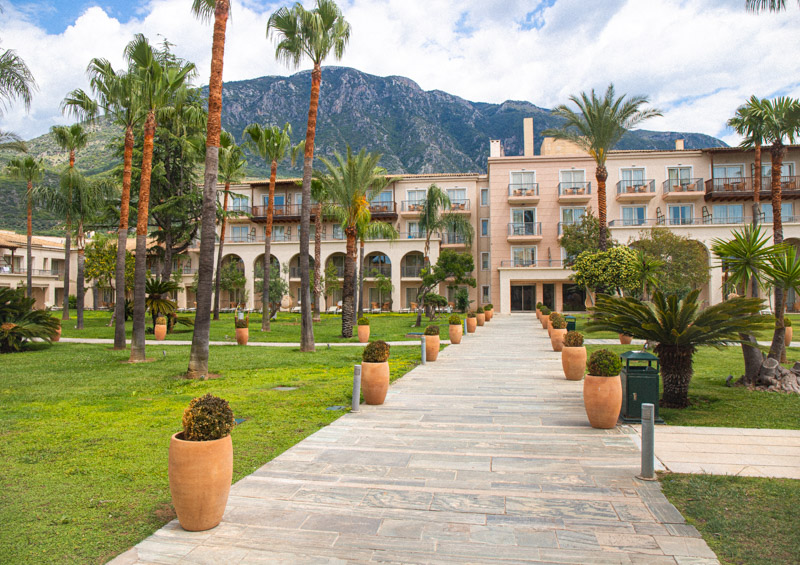
Then it was time to check into my accommodation for the next five nights for my conference. The Grecotel Filoxenia. I loved how spacious my suite was and its perfect location on the beach. I made sure to fit in in time to relax by the pool, and swim in the (slightly chilly) Messinian Gulf.
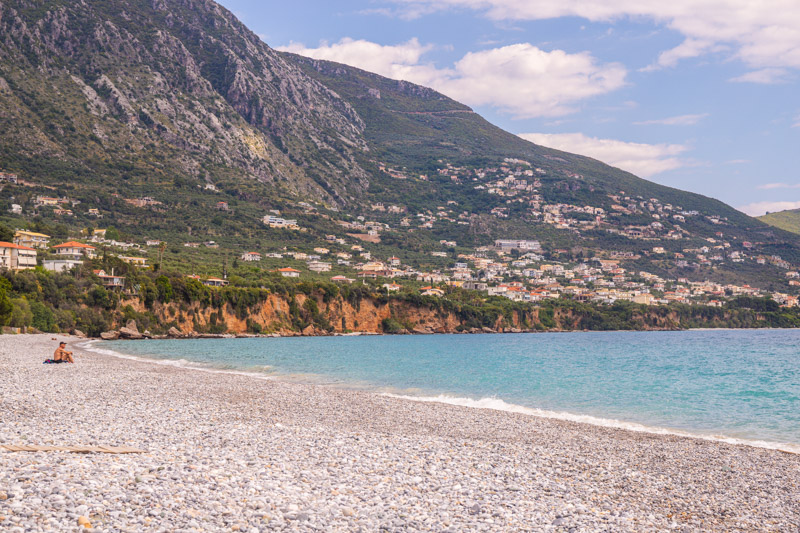
This is the perfect place to stay in Kalamata for those wanting a little restful oasis after a day exploring. With all the amenities right there, it’s a perfect accommodation choice for families.
Day 5: Day Trip from Kalamata to Kardamyli
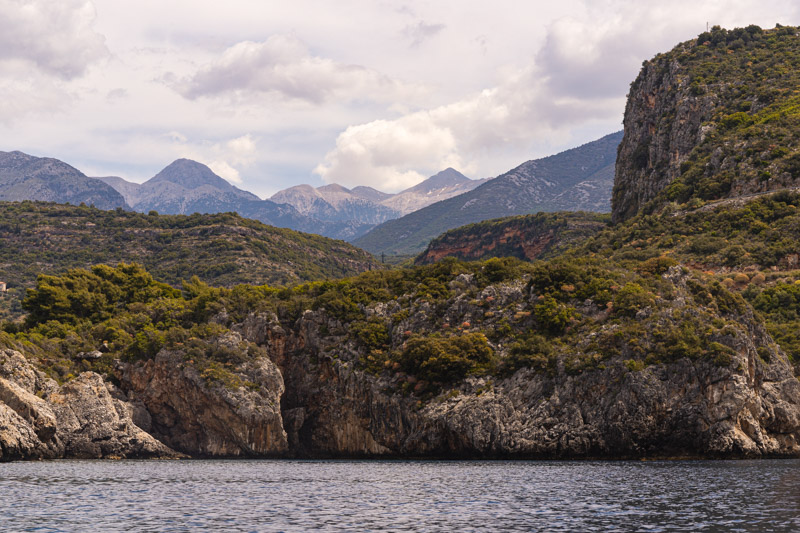
Picturesque Kardamyli is a sleepy fishing village on the shores of the Messenian Gulf about an hour from Kalamata.
This is a hidden gem in the Peloponnese beckons travelers to unwind and reconnect with nature, explore the narrow cobblestone streets of the village, embark on adventurous hikes through the surrounding mountains and olive groves, and paddle the crystal-clear waters and sea caves.
To begin our day in Kardamyli our group split up with some choosing to have coffee in the village with others taking a two-hour hike along the trail of the ancient so-called ‘’royal street’’ connecting Kardamyli with Sparta during ancient years.
My small group chose to do the two-hour sea kayaking adventure.
Stop 1: Sea Kayaking in Kardamyli
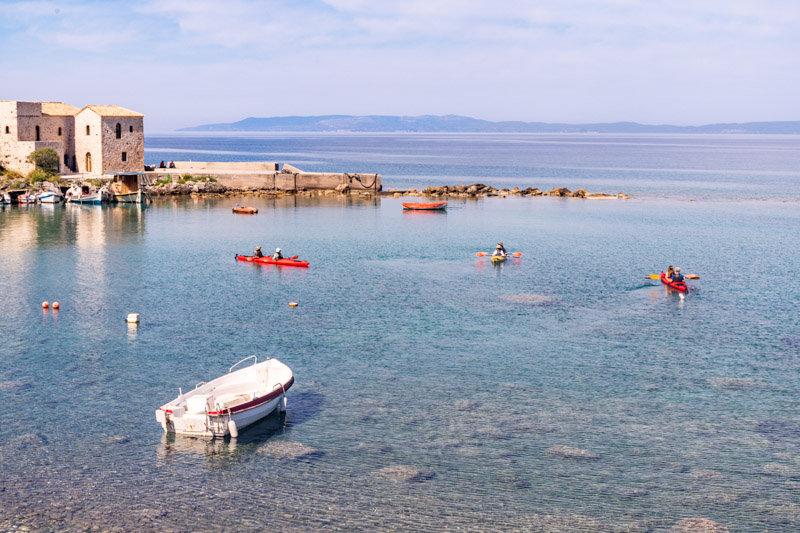
Many will say sea kayaking in Kardamyli was the best of their Peloponnese holiday. It was certainly one of my favorite things to do.
Our guides from Explore Messini were passionate, friendly and shared many stories about the history and culture of the Mani Peninsula.
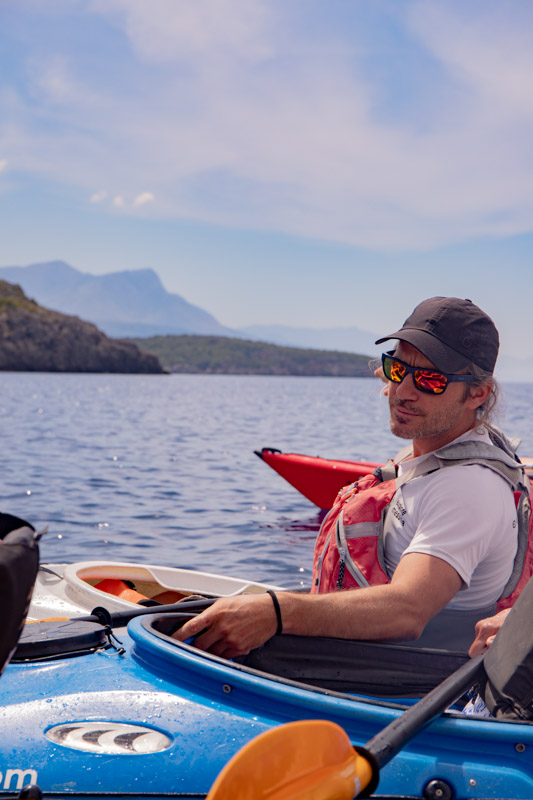
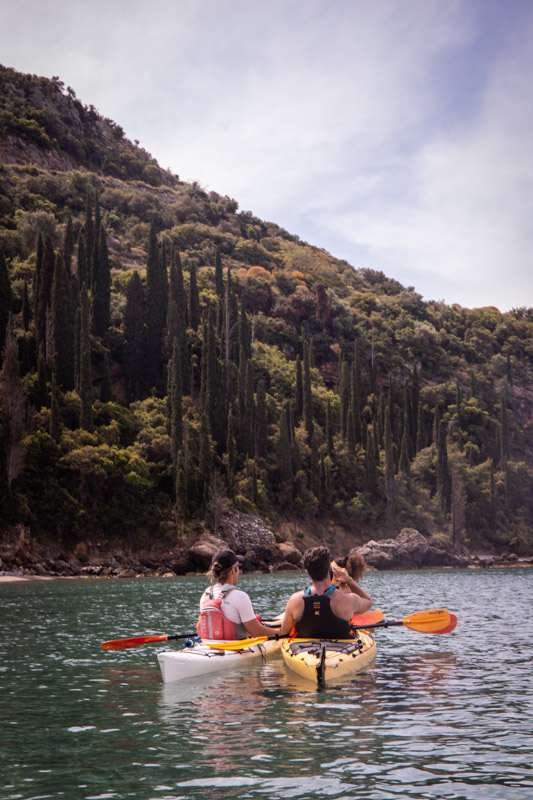
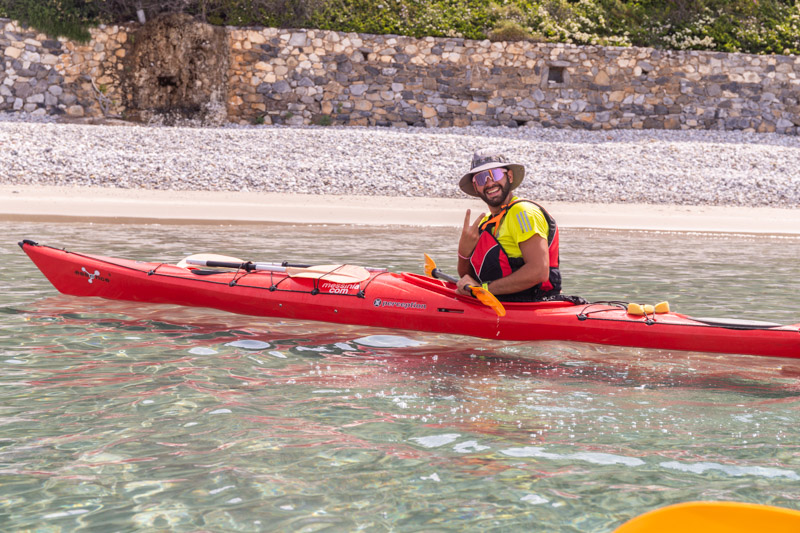
I regretted not adding more time in this region to my Peloponnese road trip (It is the hidden gem of the Peloponnese).
The road into this peninsula was only opened in the 1970s and is used to be the home of pirates and vendetta families!
We did a shortened version of a four-hour kayaking trip which also includes more caves and picnics on the beach (and swimming).
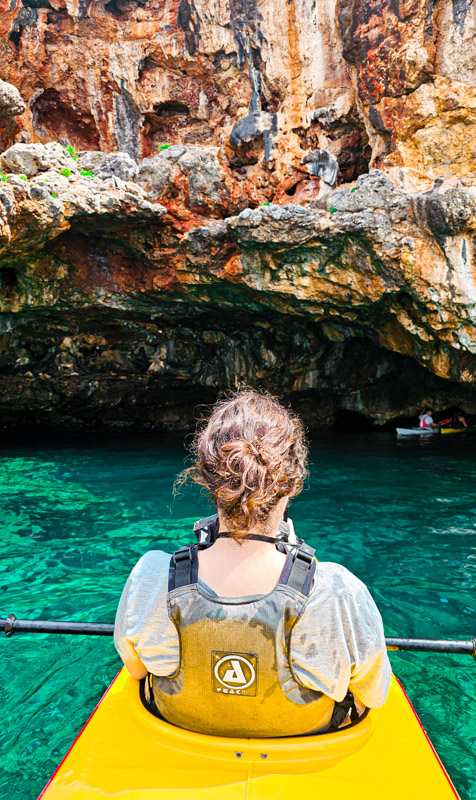
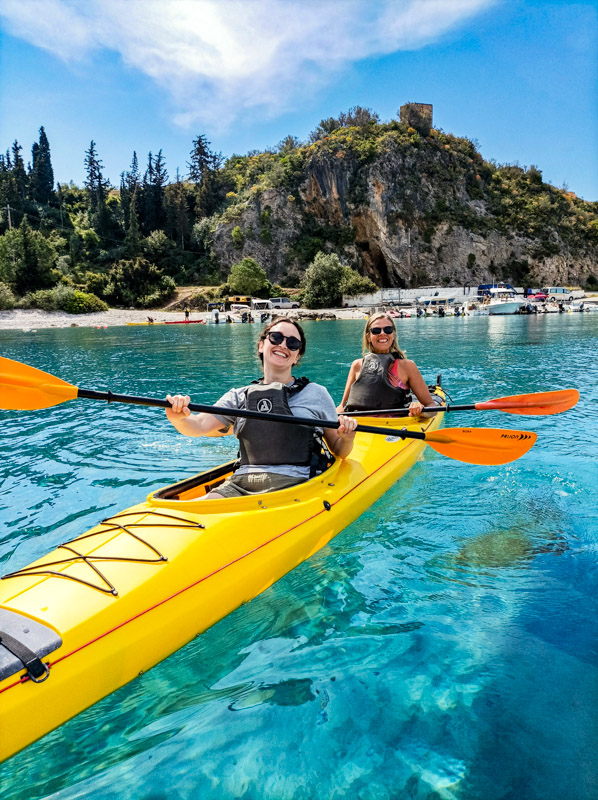
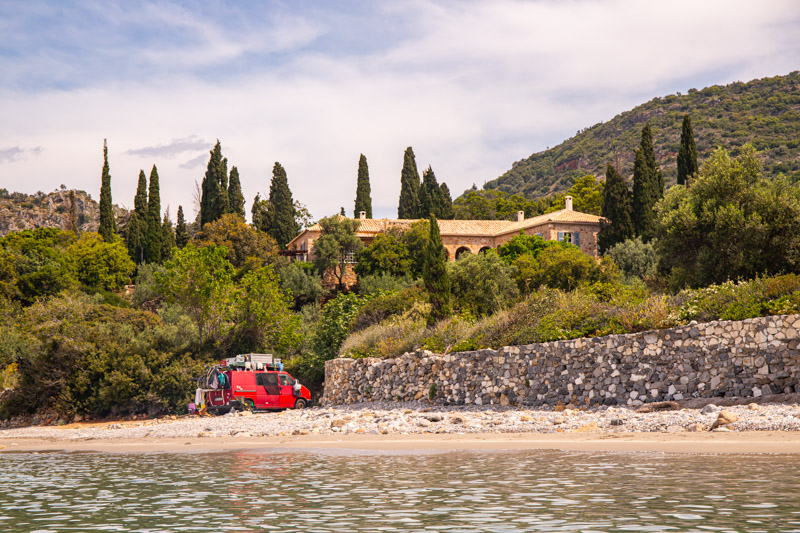
Along the way we stopped at Turtle Island, famous British travel writer Patrick Leigh Fermor’s House (see next section), to gaze upon pyramid shaped Taygetos, the highest mountain in the Peloponnese, with a height of 2407 meters, and to paddle into a Seals’ Cave to see the luminescent cobalt blue water.
Stop 2: Visit the Patrick Leigh Fermor House
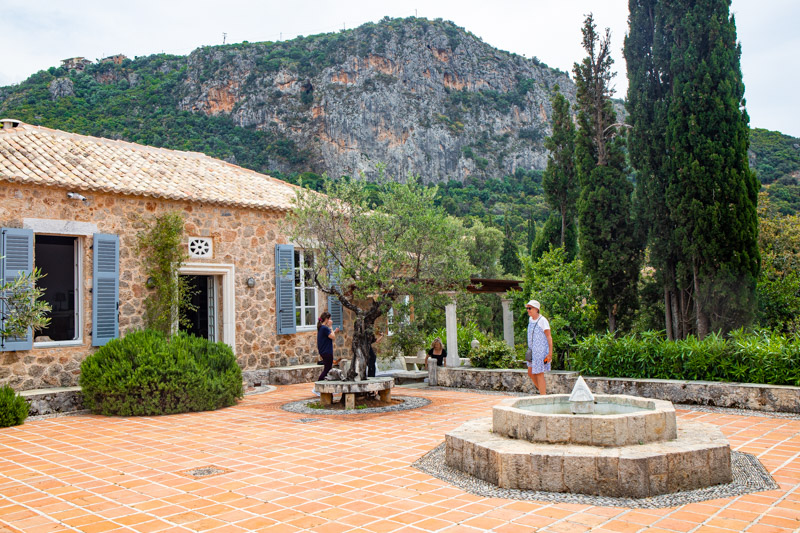
Our group reconnected at the stunning Patrick Leigh Fermor House, which we had seen from the kayaks.
This historic house was once the beloved residence of Patrick Leigh Fermor, a renowned British travel writer and war hero who found inspiration in the tranquil beauty of Kardamyli. He walked from England to Greece and fell in love with this sleepy village and decided to stay:
“We walked down into a gently sloping world of the utmost magical beauty…thick with magnificent olive trees and lots of other trees… Behind, the peninsula melted into a great conch of grey and orange rock. I knew I would never leave.”
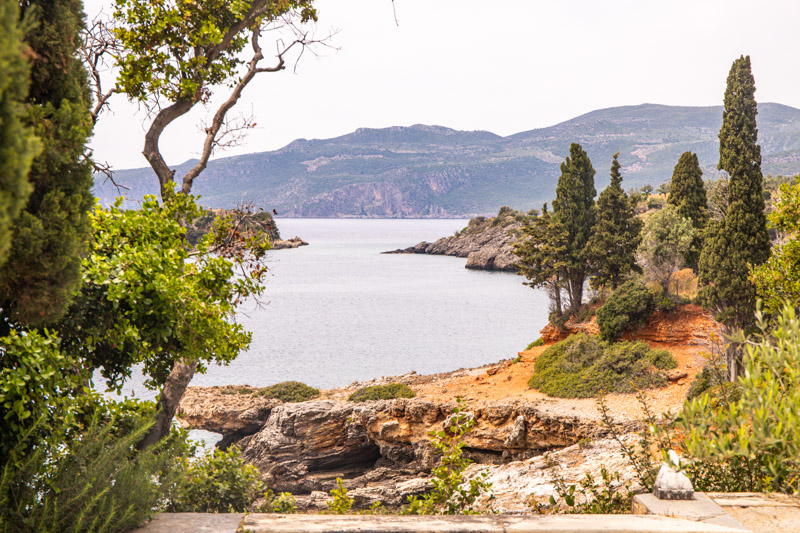
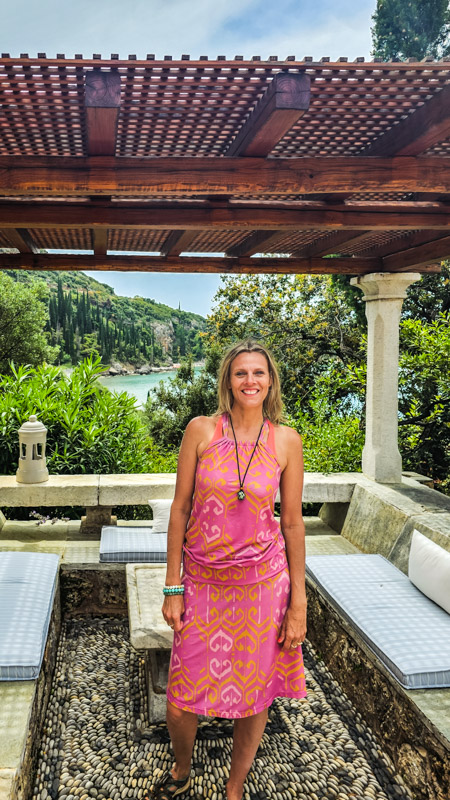
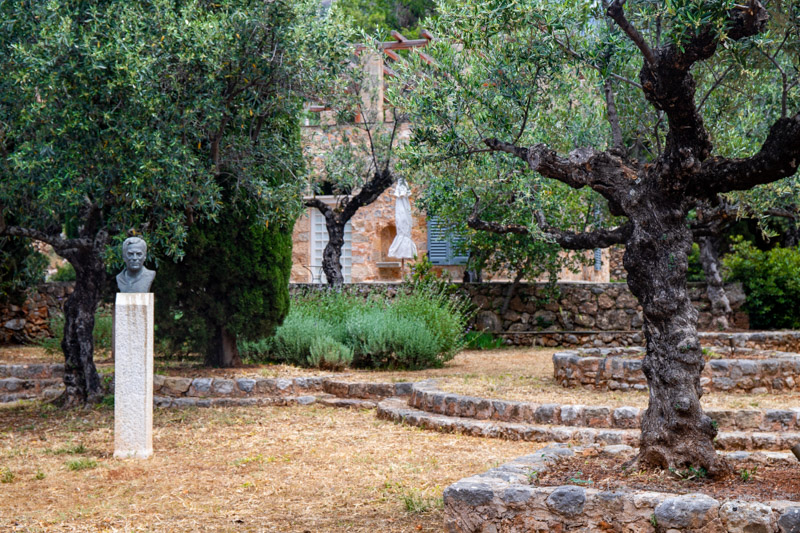
The house, now a museum, offers a unique glimpse into Fermor’s extraordinary life and his deep connection to Greece. You can explore the rooms filled with his personal belongings, browse his extensive library, and wander through the lush gardens that overlook the azure waters of the Mediterranean.
The stone villa is absolutely stunning and is a place where I could see myself living and writing books. You can almost feel the echoes of literary conversations and imagine the creative spirit that thrived within its walls.

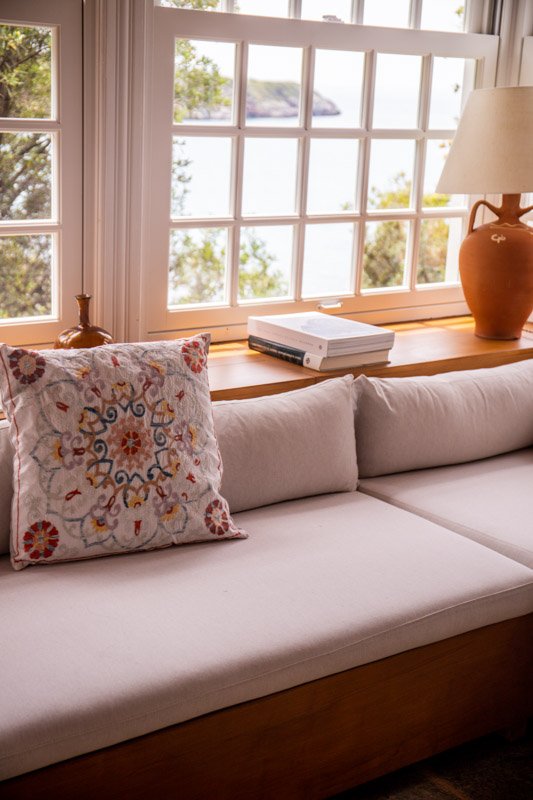

The Patrick Leigh Fermor House in Kardamyli will hold a special place in the hearts of literature enthusiasts and history buffs alike.
For the summer months the Patrick Leigh Fermor House is available to rent, either the whole villa to accommodate ten people or as individual self-contained suites.
The house comes with an outdoor swimming pool, terrace, private beach area, free Wi-Fi and sprawling Mediterranean garden of olive- and cypress trees and wildflowers. It’s a pricey stay but could be your bucket list dream! See rates and availability here.
Day 6: Day Trip to Polylimnio Waterfalls and Voidokilia Beach
Here’s another wonderful day trip from Kalamata with your car rental.
Stop 1: Hike the Polylimnio Waterfall Trail
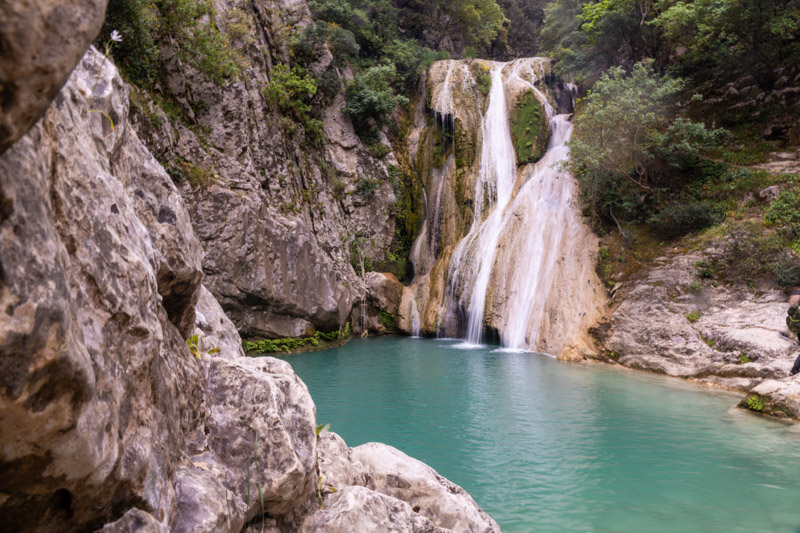
Hidden within the lush green landscape of Messenia about 40 minutes from Kalamata are the Polylimnio Waterfalls.
There is a 3km out and back trail leading you up to the main 25m Polyminio Waterfall, the stepped waterfall that creates the fifteen hidden turquoise and aqua lakes and smaller waterfalls.
It’s a pretty easy trail, although it does involve some rock scrambling so be sure to wear appropriate shoes.
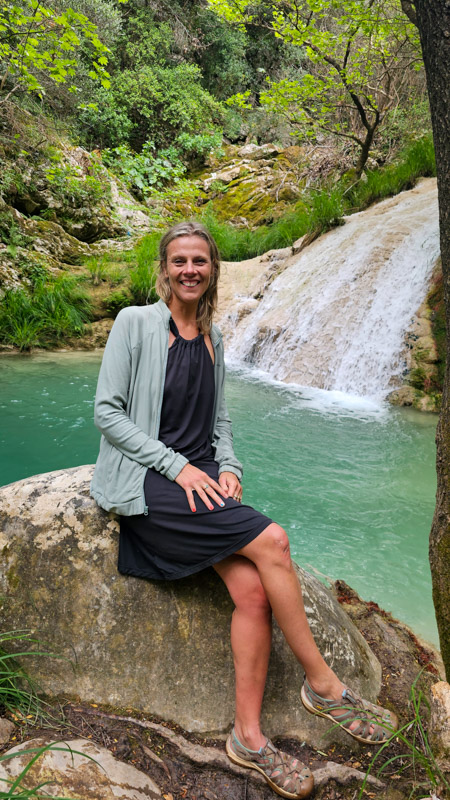
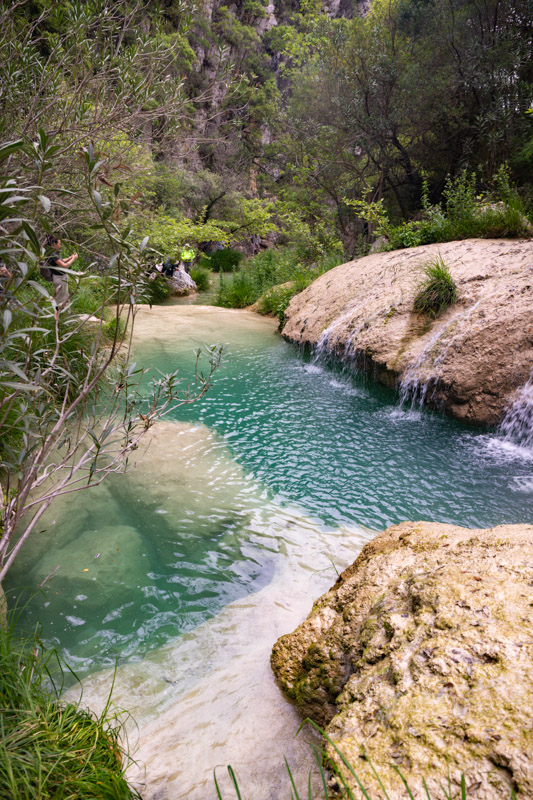
Don’t forget to bring your swimsuit. Although be prepared for chilly water, which is perfect on a hot Greek summer day. I sadly left mine in the car!
I loved this hike. It felt like I had entered a magical fairy kingdom and the color of the water was astounding – similar to the glacier fed waters you’d see in the Rockies.
If you’re a nervous hiker, or don’t want to do it on your own, you can join a guided hike. Otherwise, I think it’s easy to do on your own.
Stop 2: Visit Voidokilia Beach
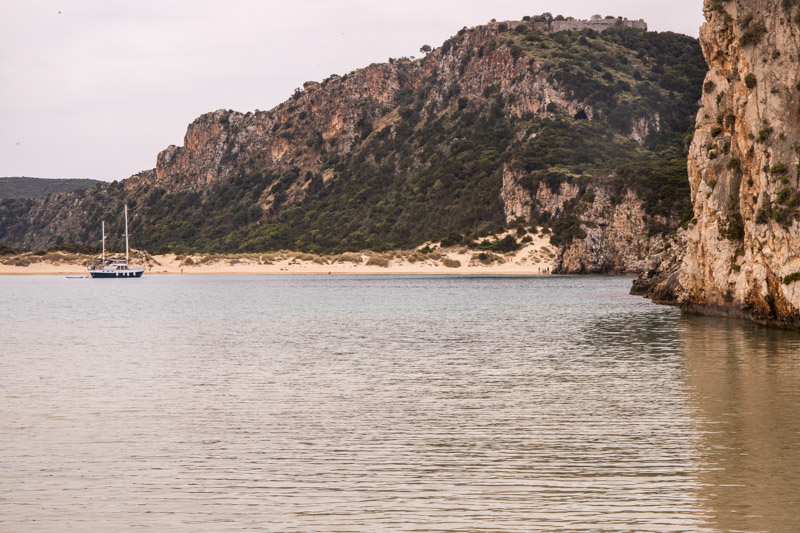
From here, continue driving west until you reach Voidokilia Beach, tucked beyond sand dunes and famous for its unique horseshoe shape, pristine white sands, and clear azure waters.
We visited on a grey day so did not get the full impact of its stunning colors and its unique shape curved like a giant Greek omega – best viewed from the two rocky promontories that define the entrance of the beach.
Or the curvature also looks like an ox’s belly, which has ties to the meaning of its name, which originates from Voufras, which translates as “where oxen live.”
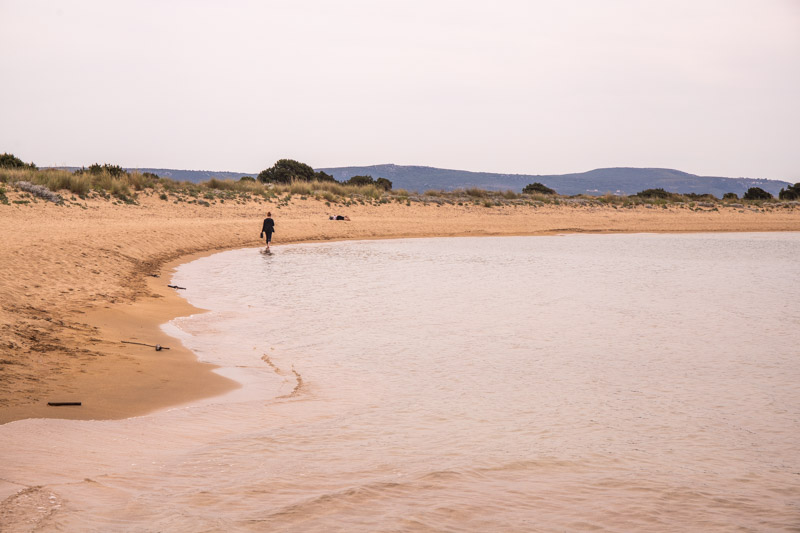
Because of the weather, we decided to forgo hiking up to the cliff top for that Instagrammable view.
But I enjoyed seeing its pristine beauty from the shores of the bay. Its calmness makes it an excellent spot for swimming and snorkeling,
This is a protected area, so you won’t find any development or facilities. Also protected, next to the beach is the Gialova Lagoon, a brackish body of water that serves as a wildlife habitat, particularly for migratory birds.
Day 7: Drive back to Athens
On the seventh and last day, it’s time to drive back to Athens or onto the next destination of your trip.
FAQs About Visiting the Peloponnese
Here are some commonly asked questions about visiting the Peloponnese…
Where is the Peloponnese?
The Peloponnese is a region on mainland Greece. It’s located on the southern part of the mainland of Greece, known as the Peloponnese peninsula, and covers an area of 21,550 square km.
What cities are in the Peloponnese?
The largest city in the Peloponnese is Patras. Some other major towns and cities include Argos, Aigio, Amaliada, Corinth, Kalamata, Nafplio, Pyrgos, Tripoli, and Sparta.
What popular towns are in the Peloponnese?
Some of the most popular towns int he Peloponnese are Meteora, Pylos and Thessaloniki.
Is it easy to drive in the Peloponnese?
Yes, it’s very easy to drive in the Peloponnese. The roads are a combination of motorways and national roads, so no dirt roads.
Where to Stay in the Peloponnese
See a wide range of available accommodation options for the Peloponnese in the handy map below. I have marked the accommodations I stayed in (including Athens) with a teal castle symbol.
Top Selling Tours in the Peloponnese
Final Thoughts on a Peloponnese Road Trip
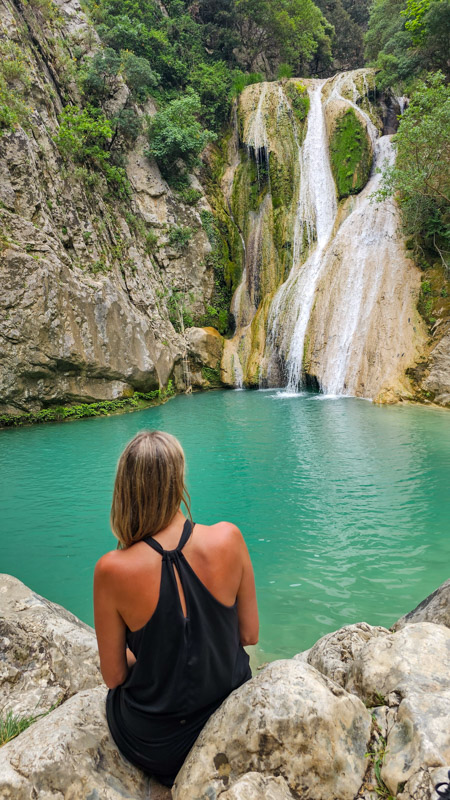
Embarking on a Peloponnese Road trip is an incredible opportunity to immerse yourself in the captivating history and breathtaking landscapes of Greece.
From ancient ruins to picturesque towns, vineyards to beautiful beaches, this region offers something for everyone. So, pack your bags, hit the road, and prepare for an unforgettable journey through the wonders of the Peloponnese.
I am so grateful for the opportunity to explore this region and create many happy memories. Travel is all about discovery, adventure, connection, and self-growth. The Peloponnese will give you all of that!
Happy travels!
[ad_2]
Source link
